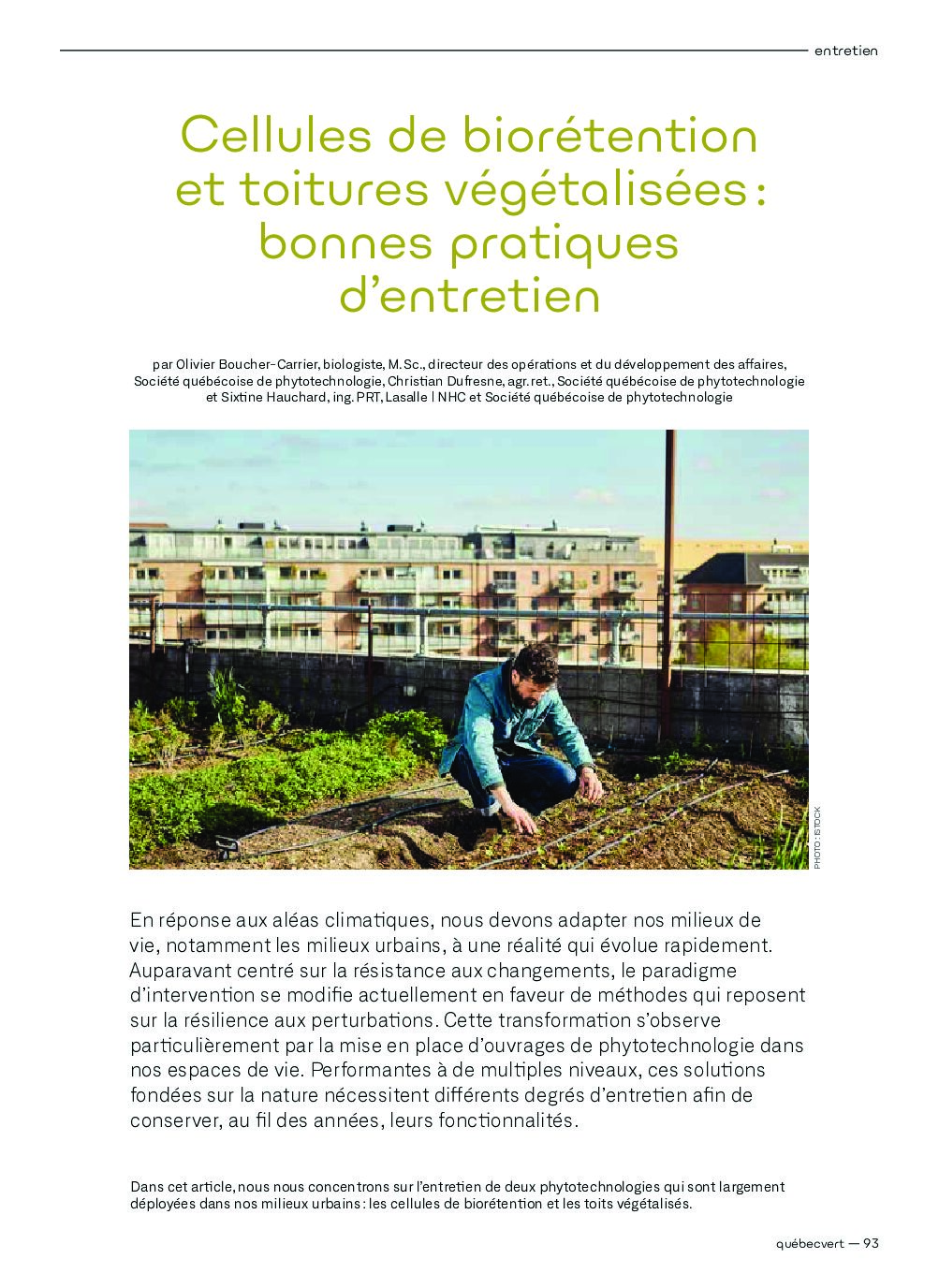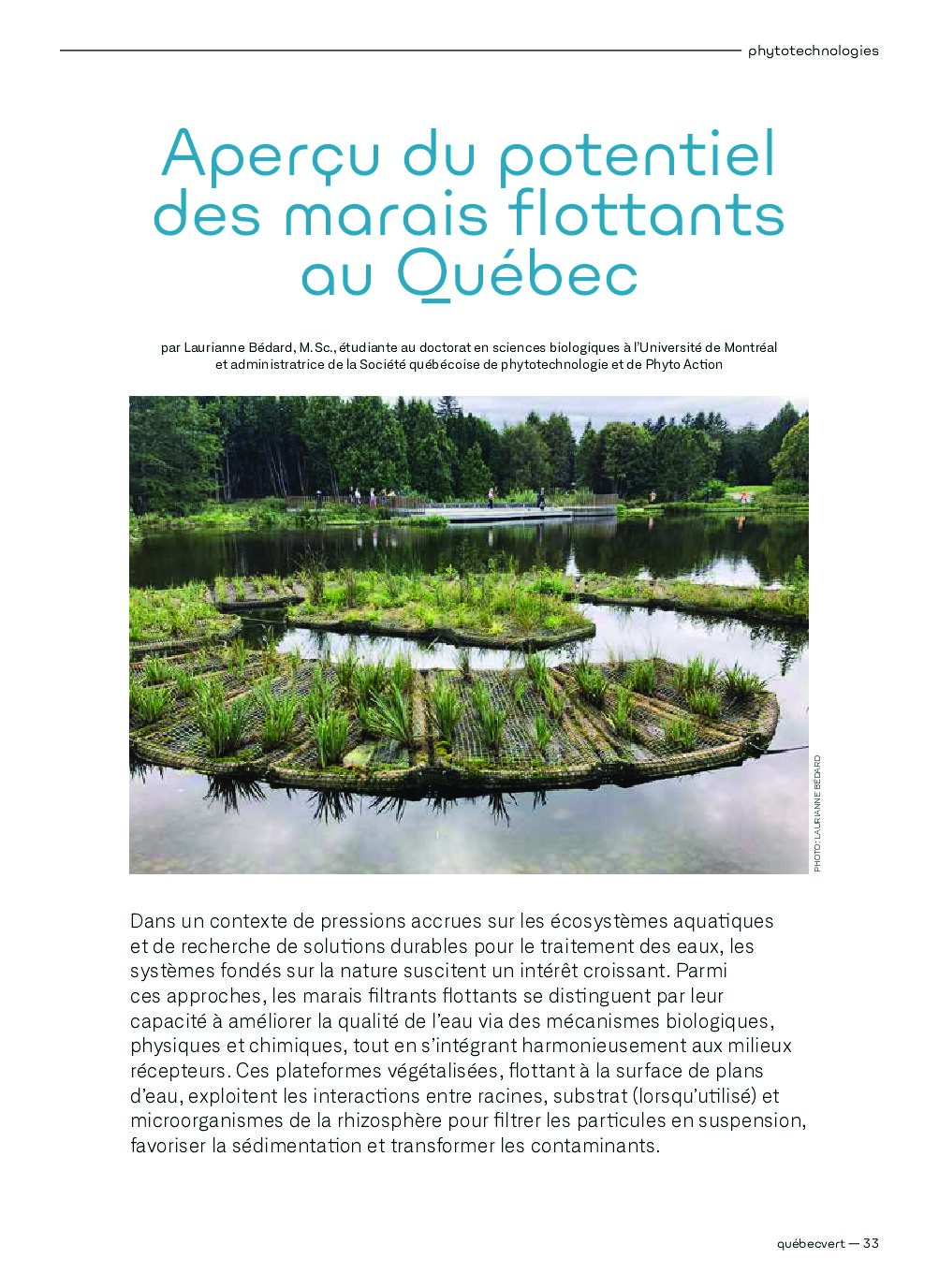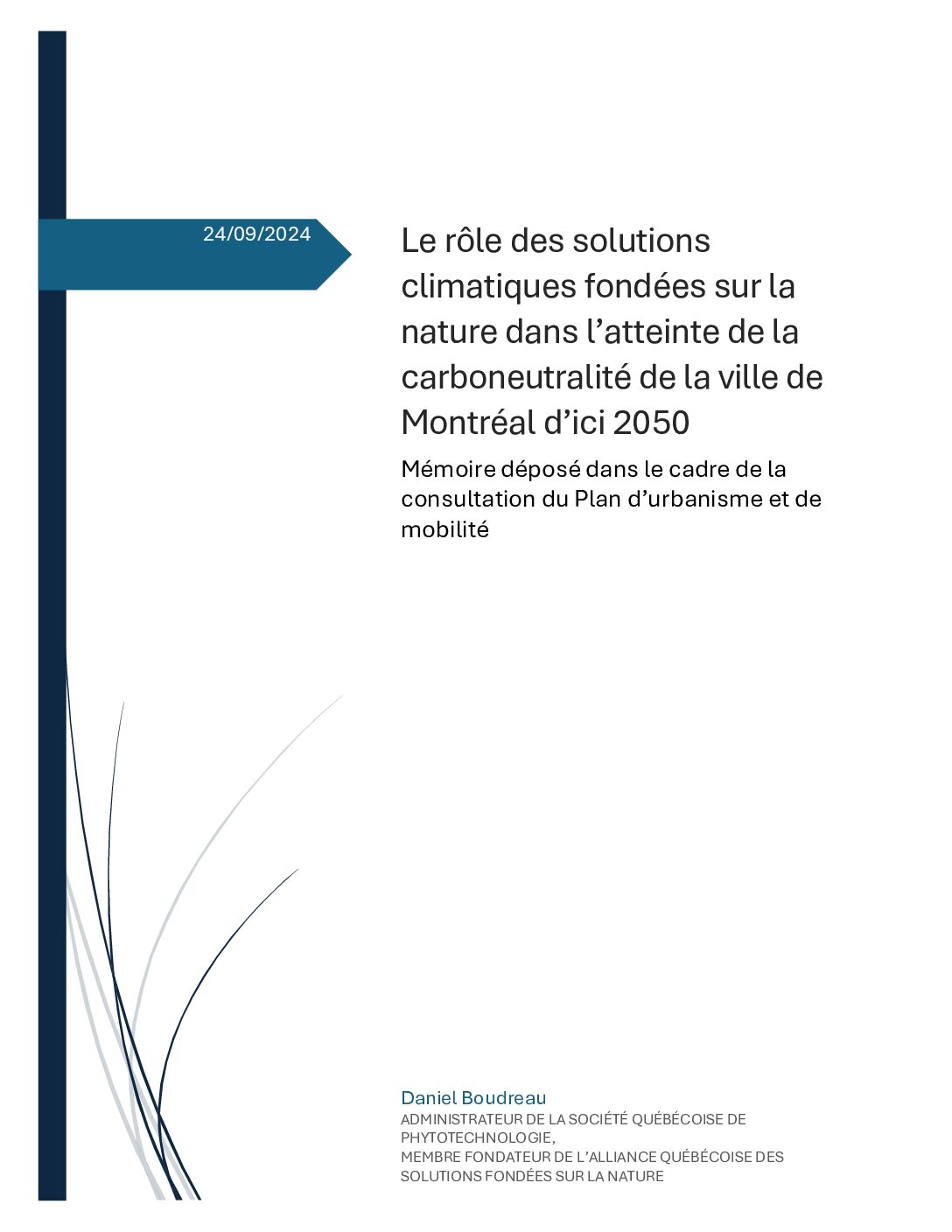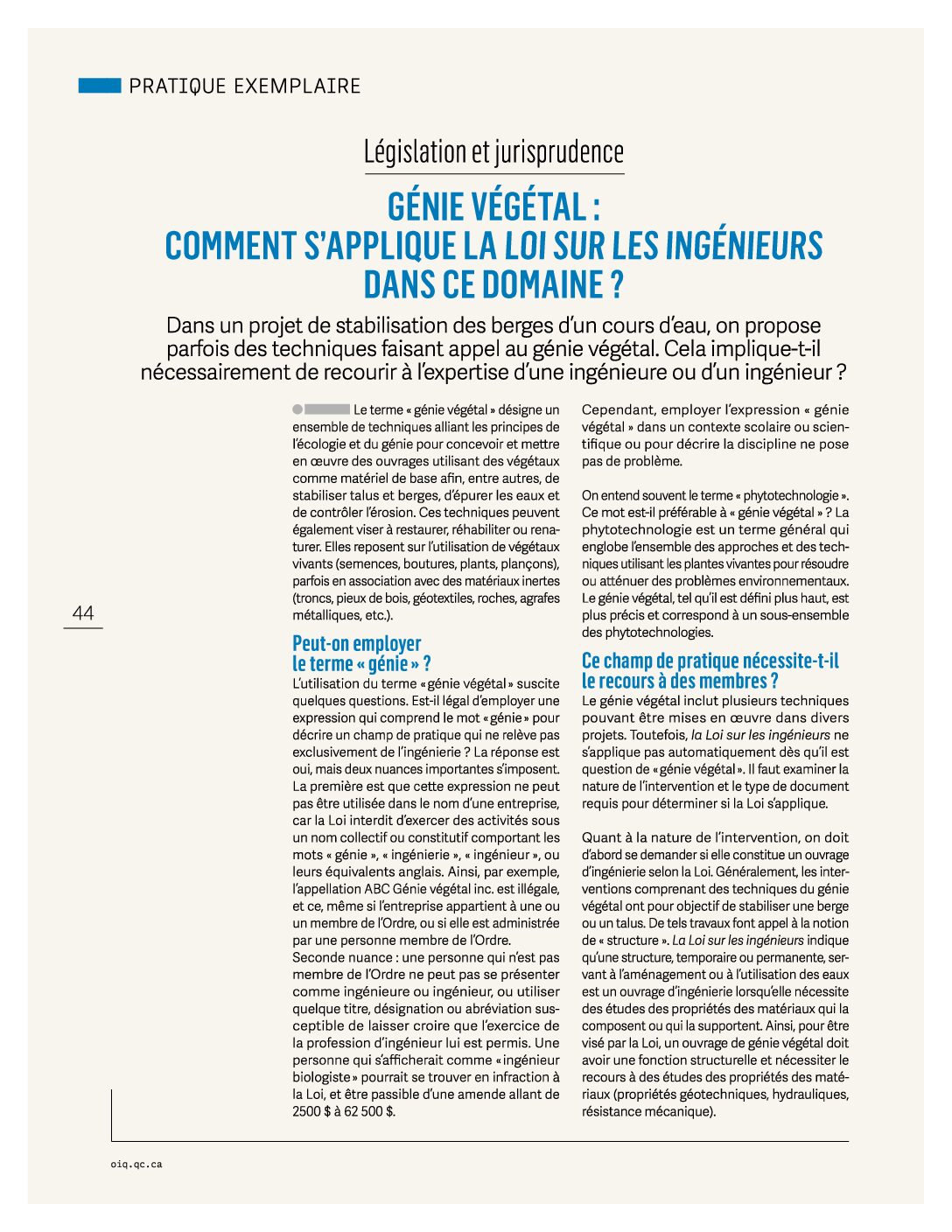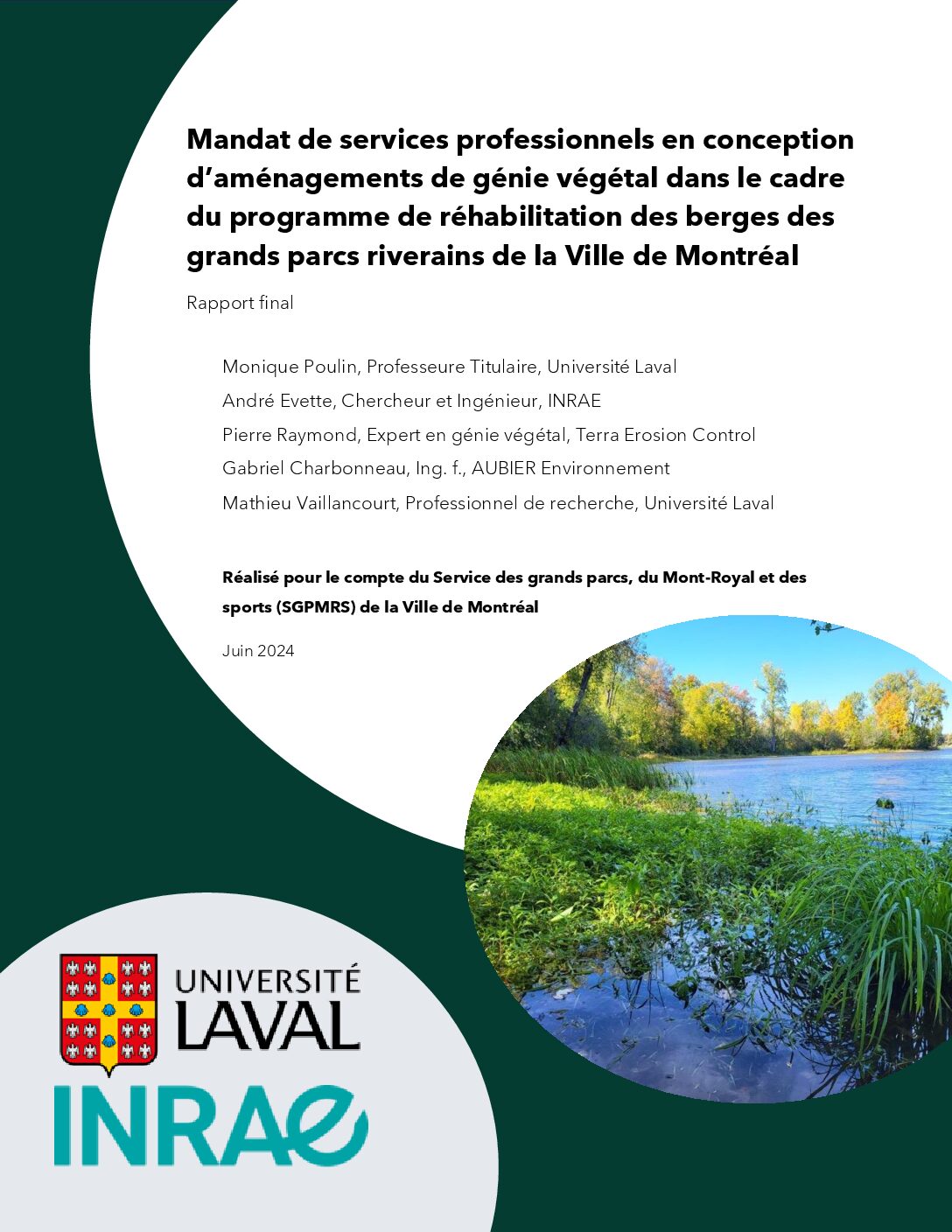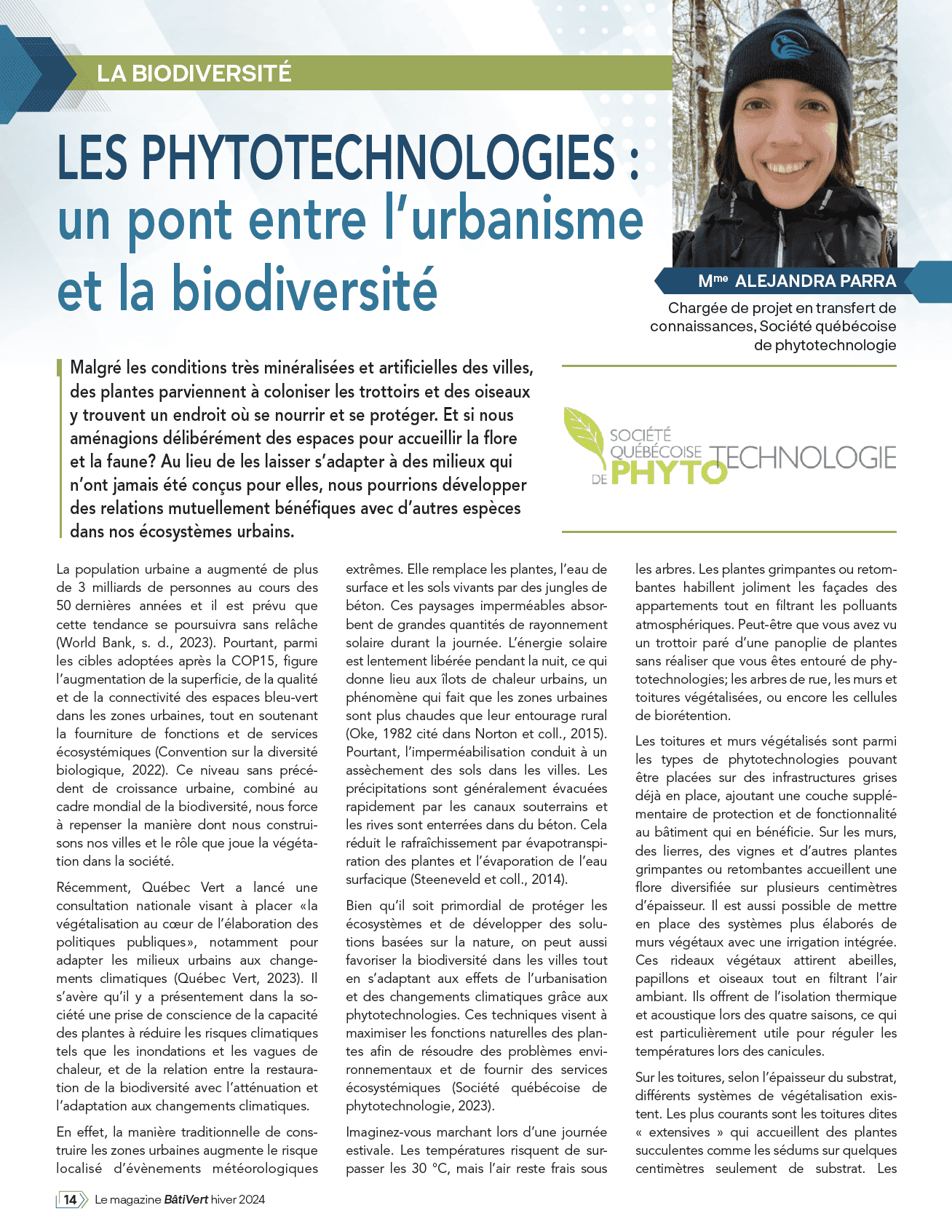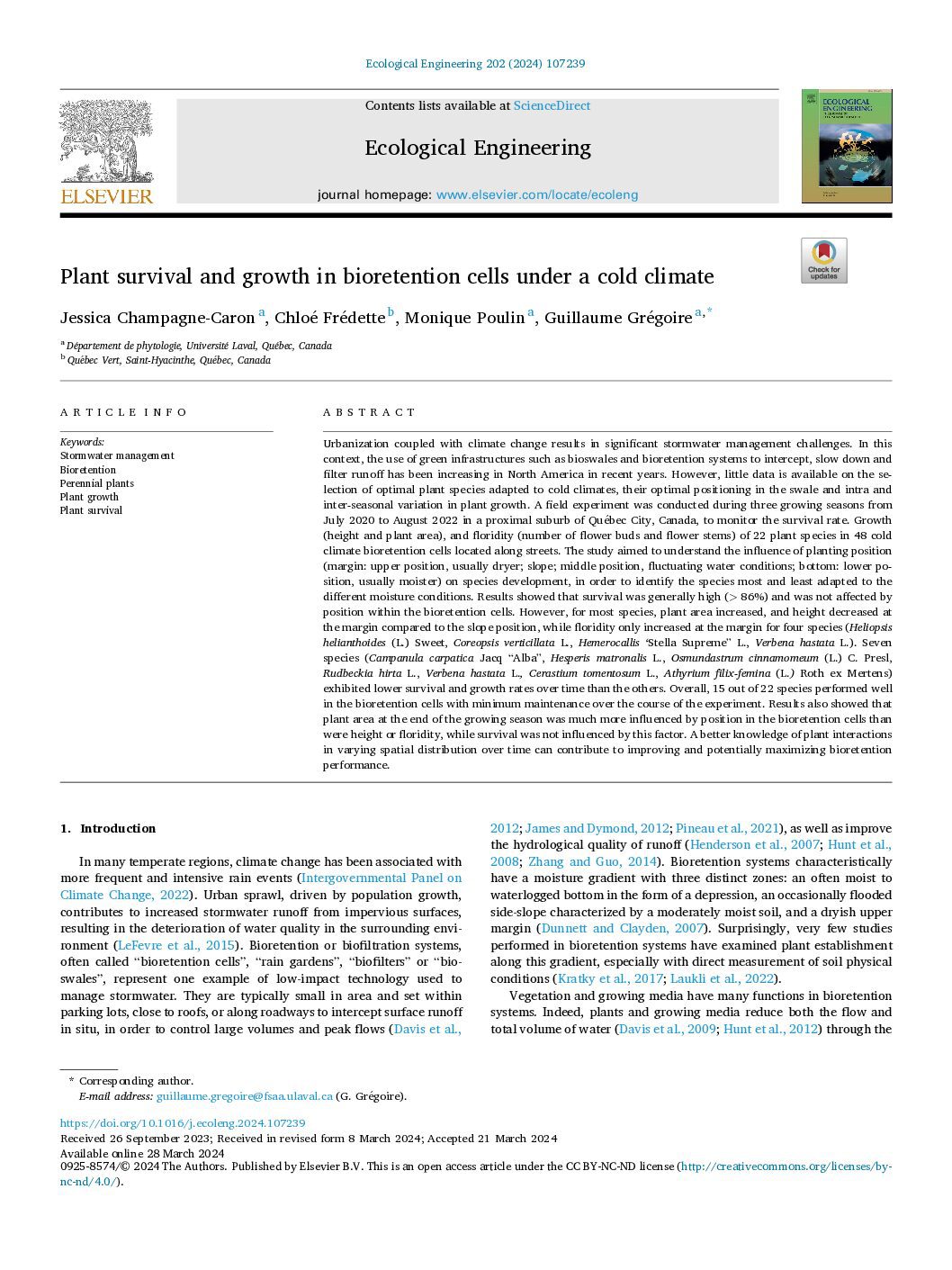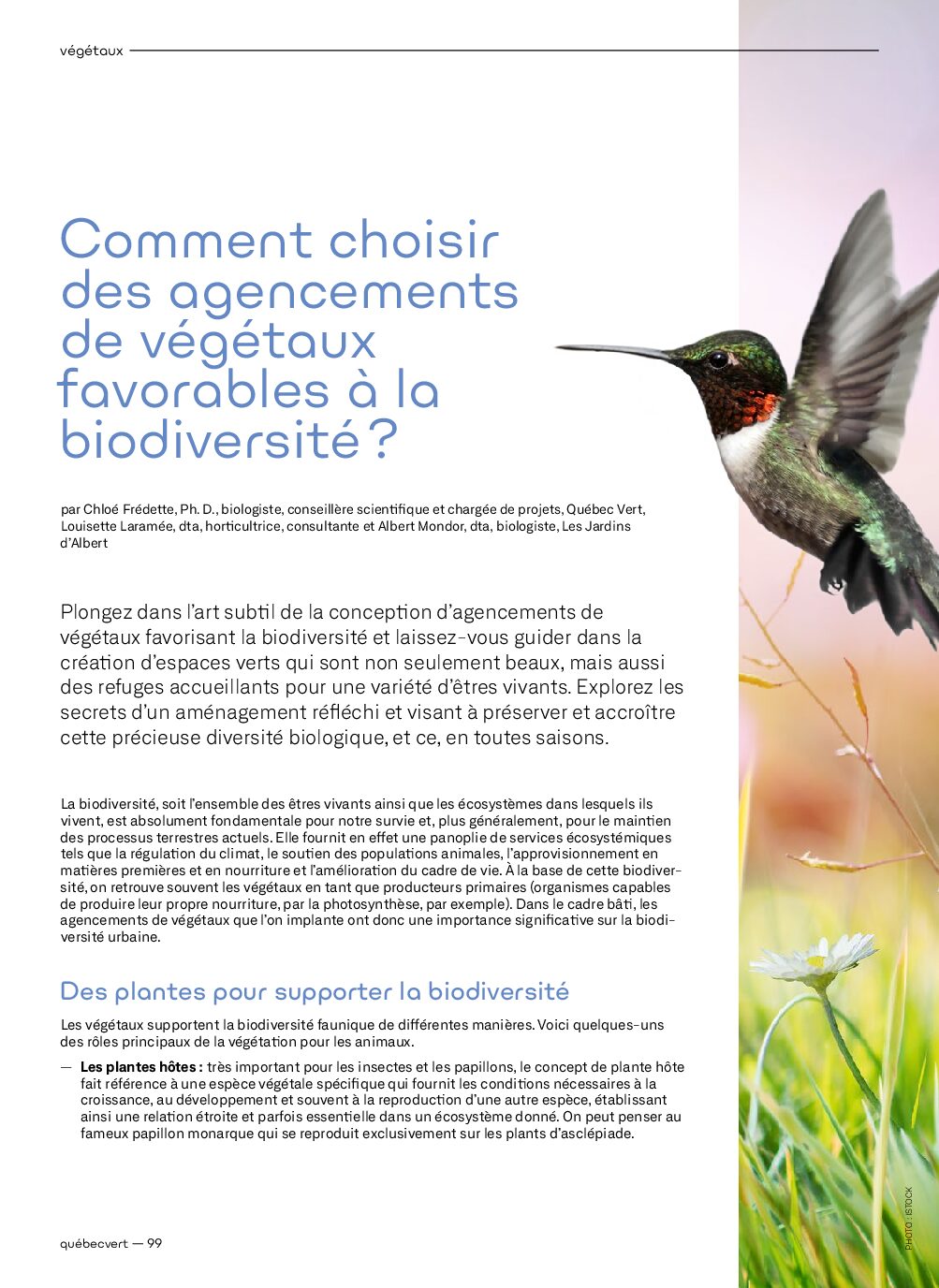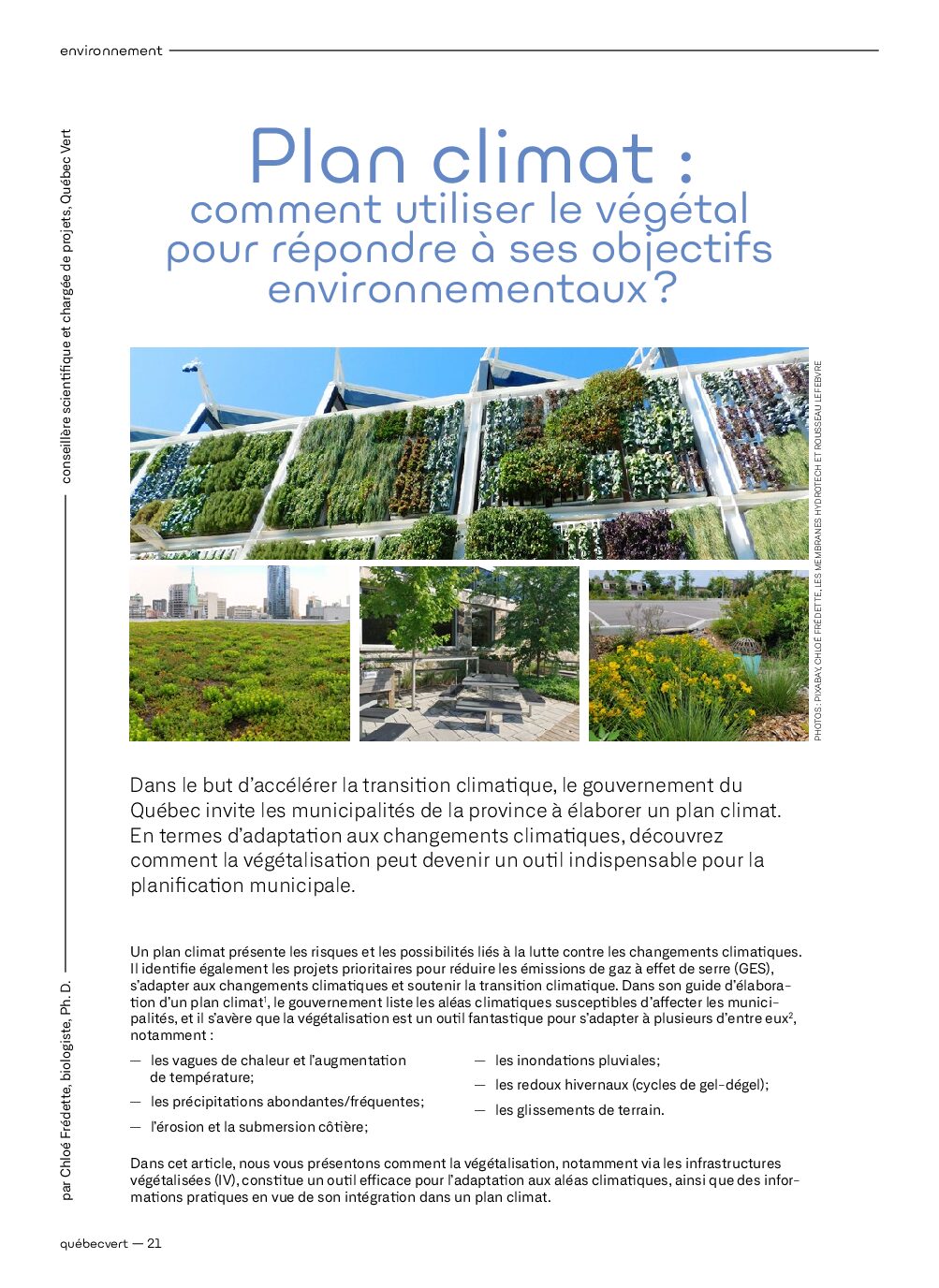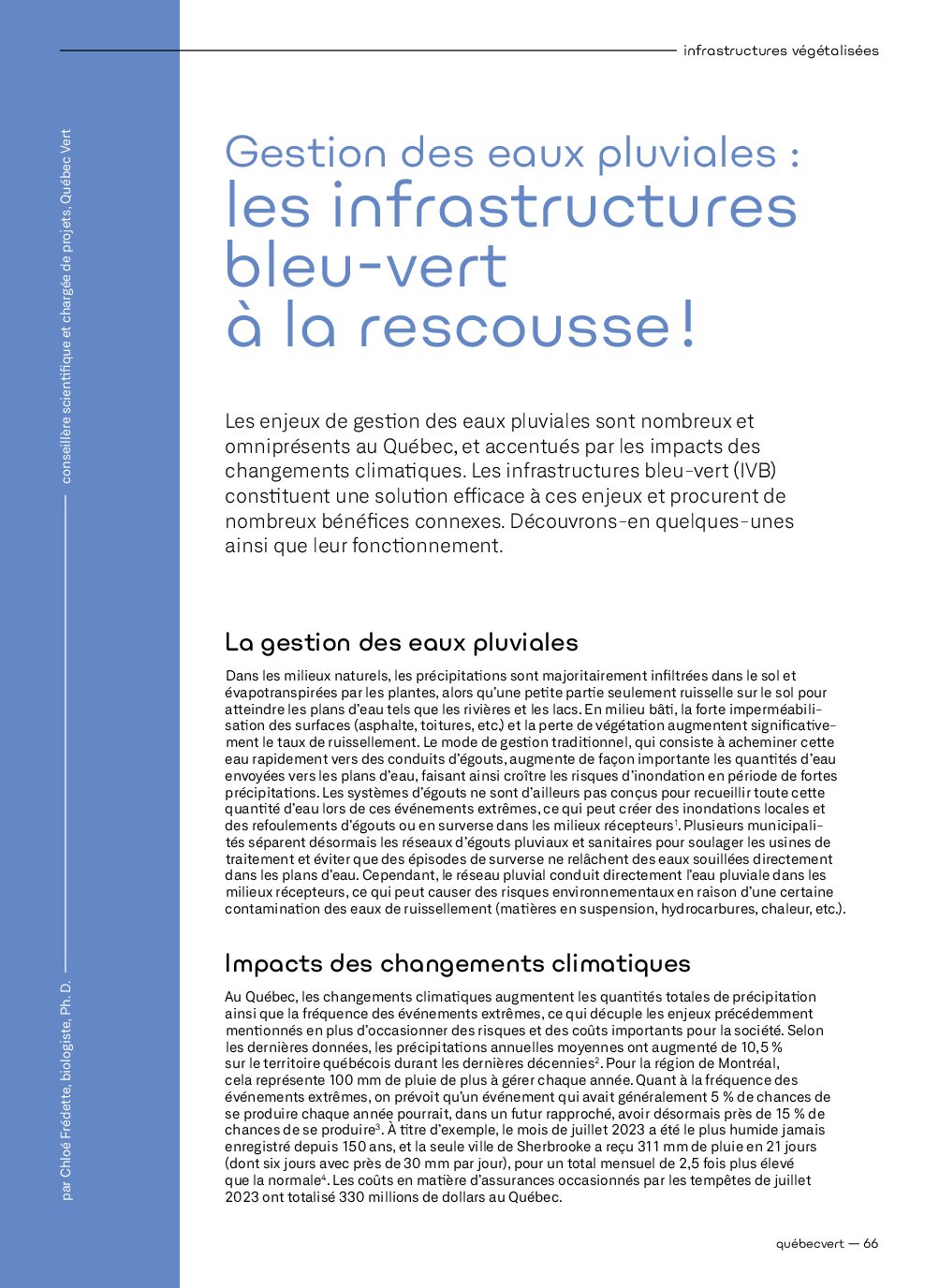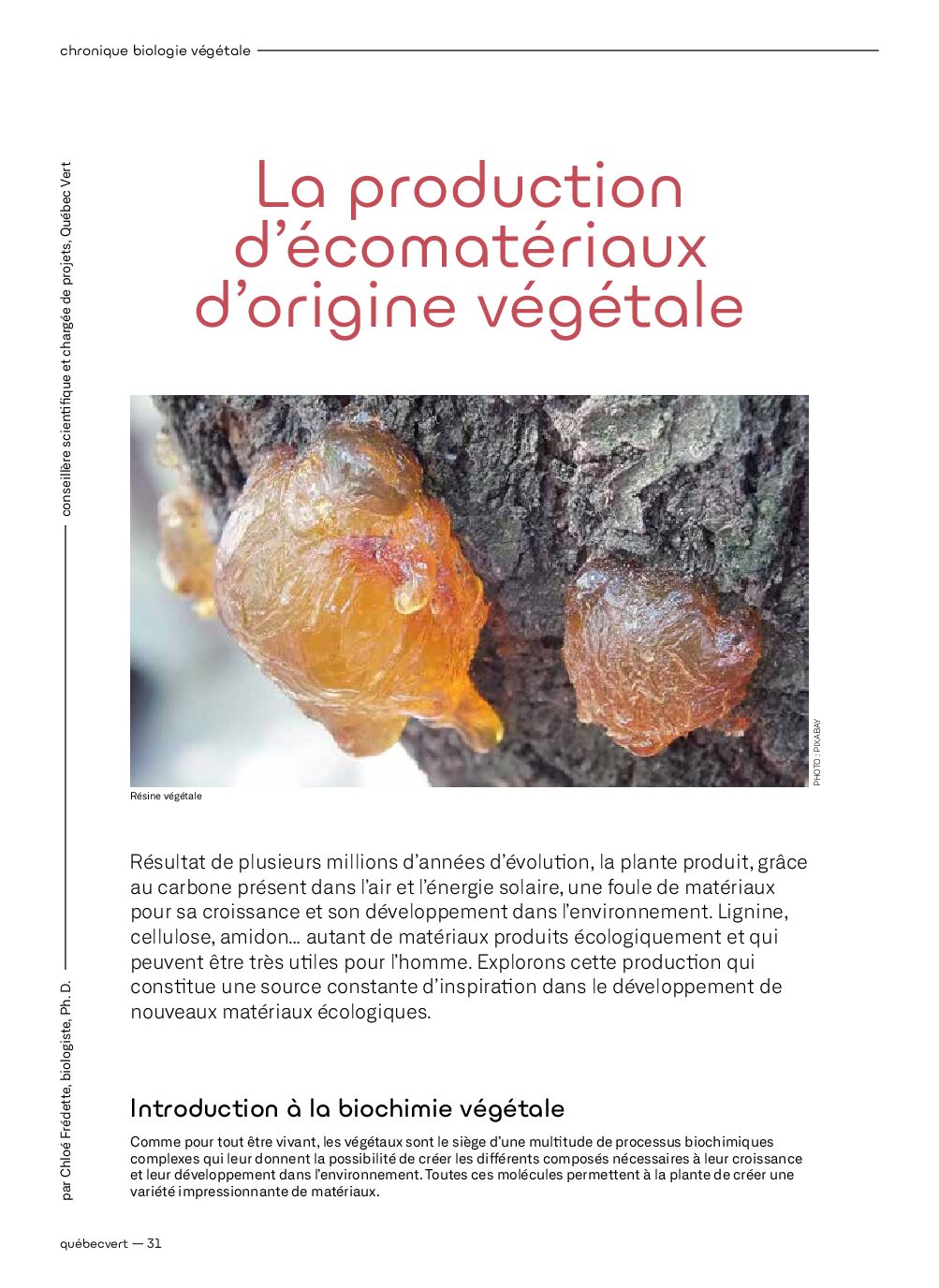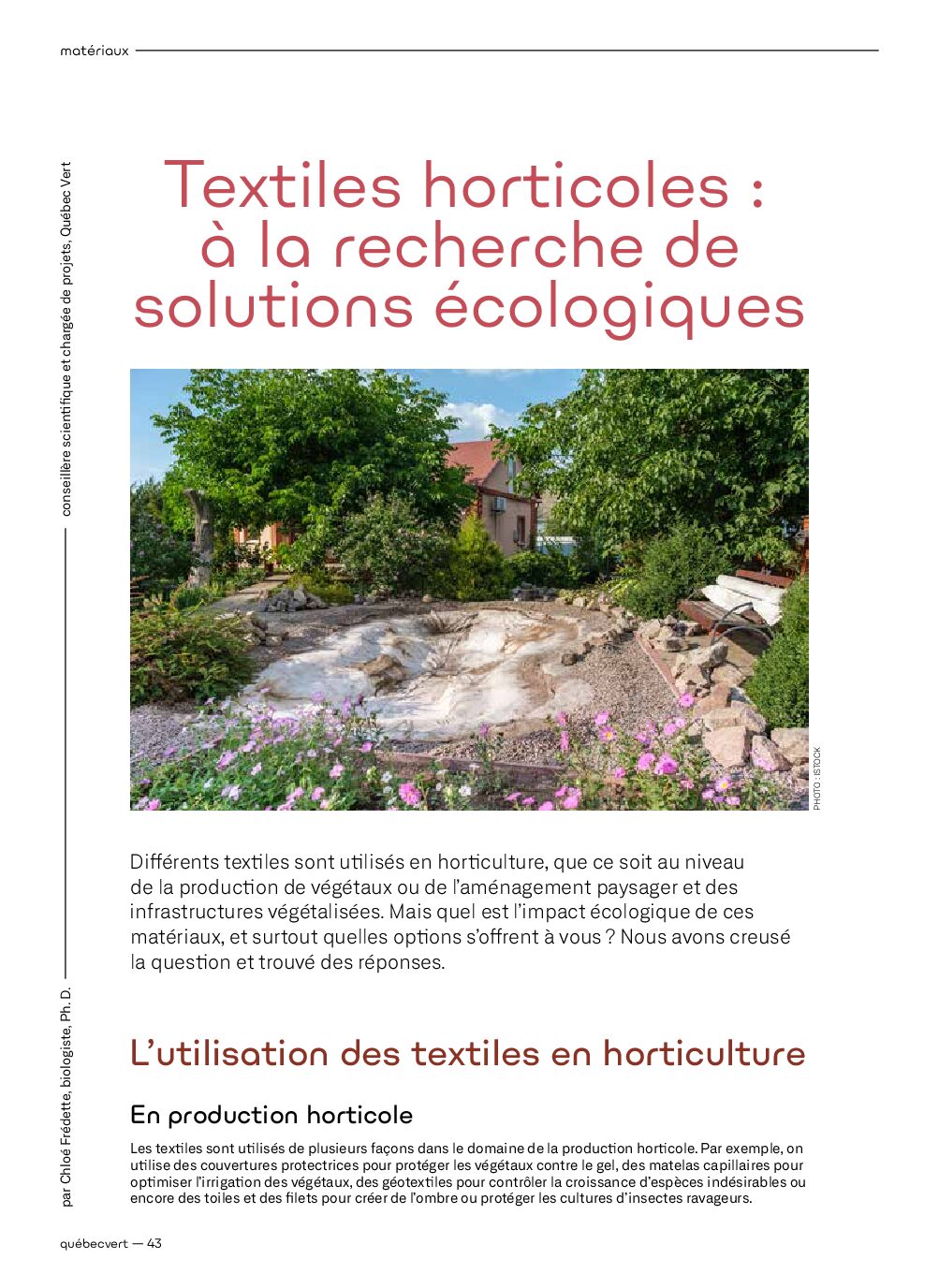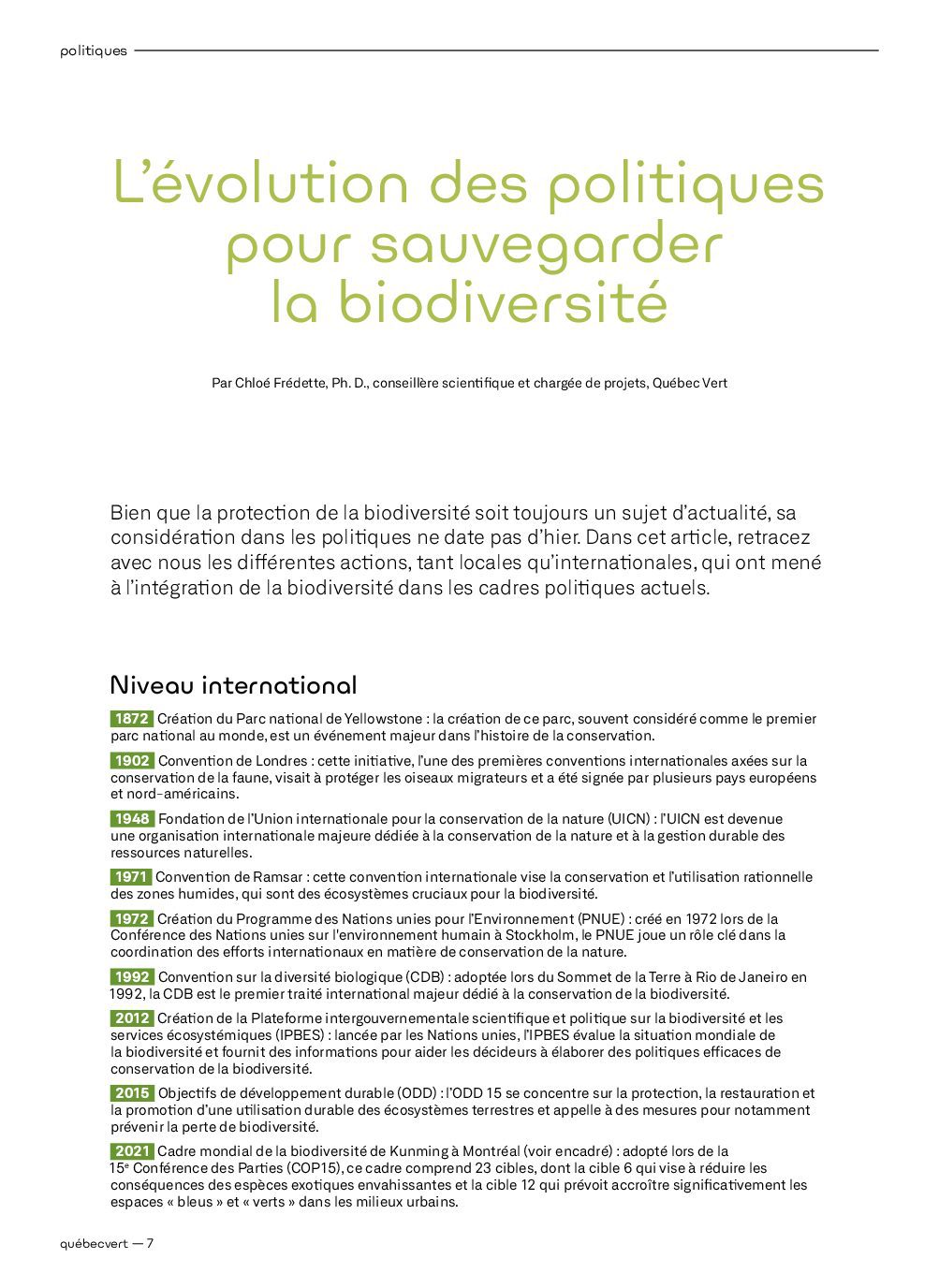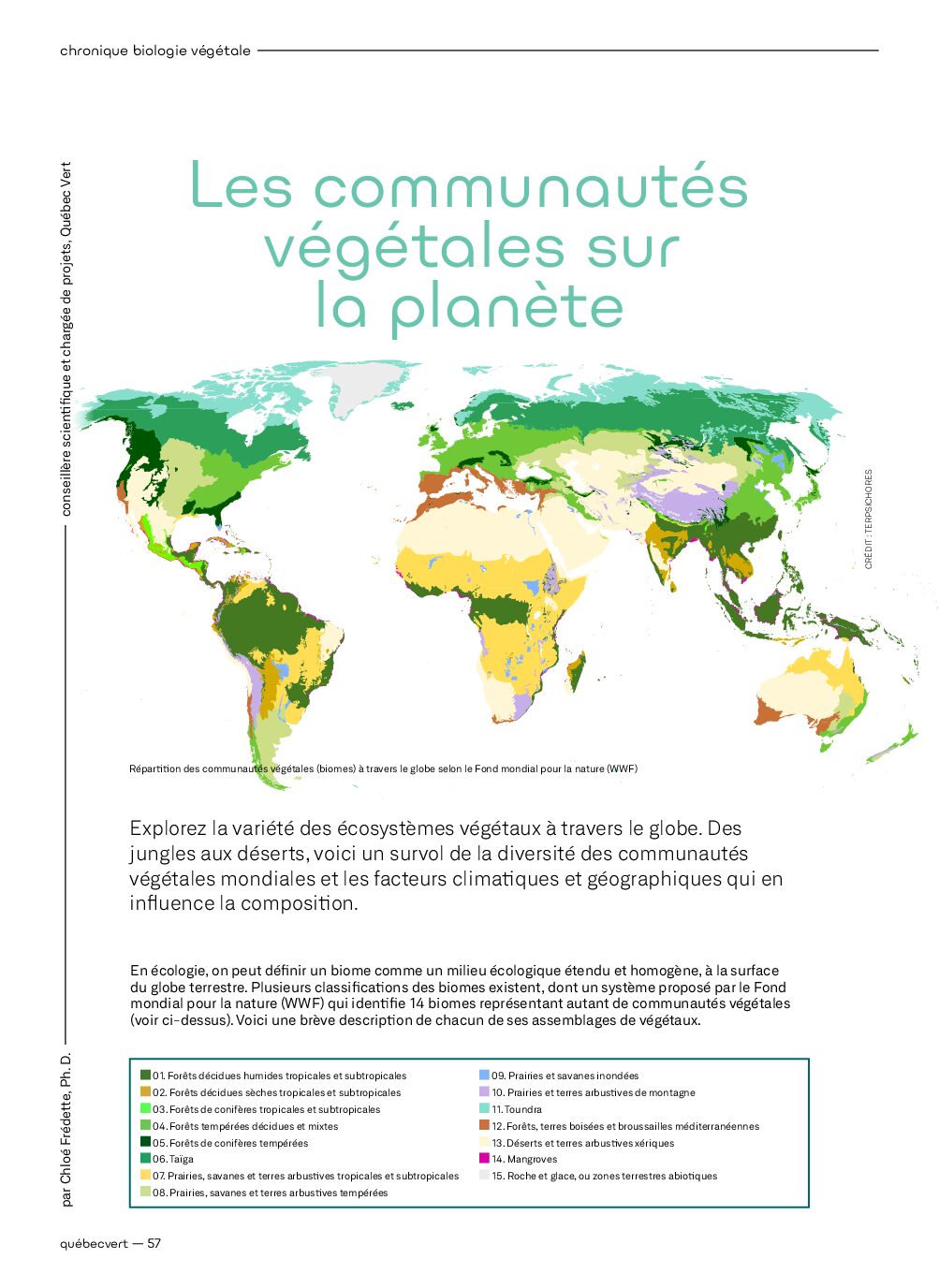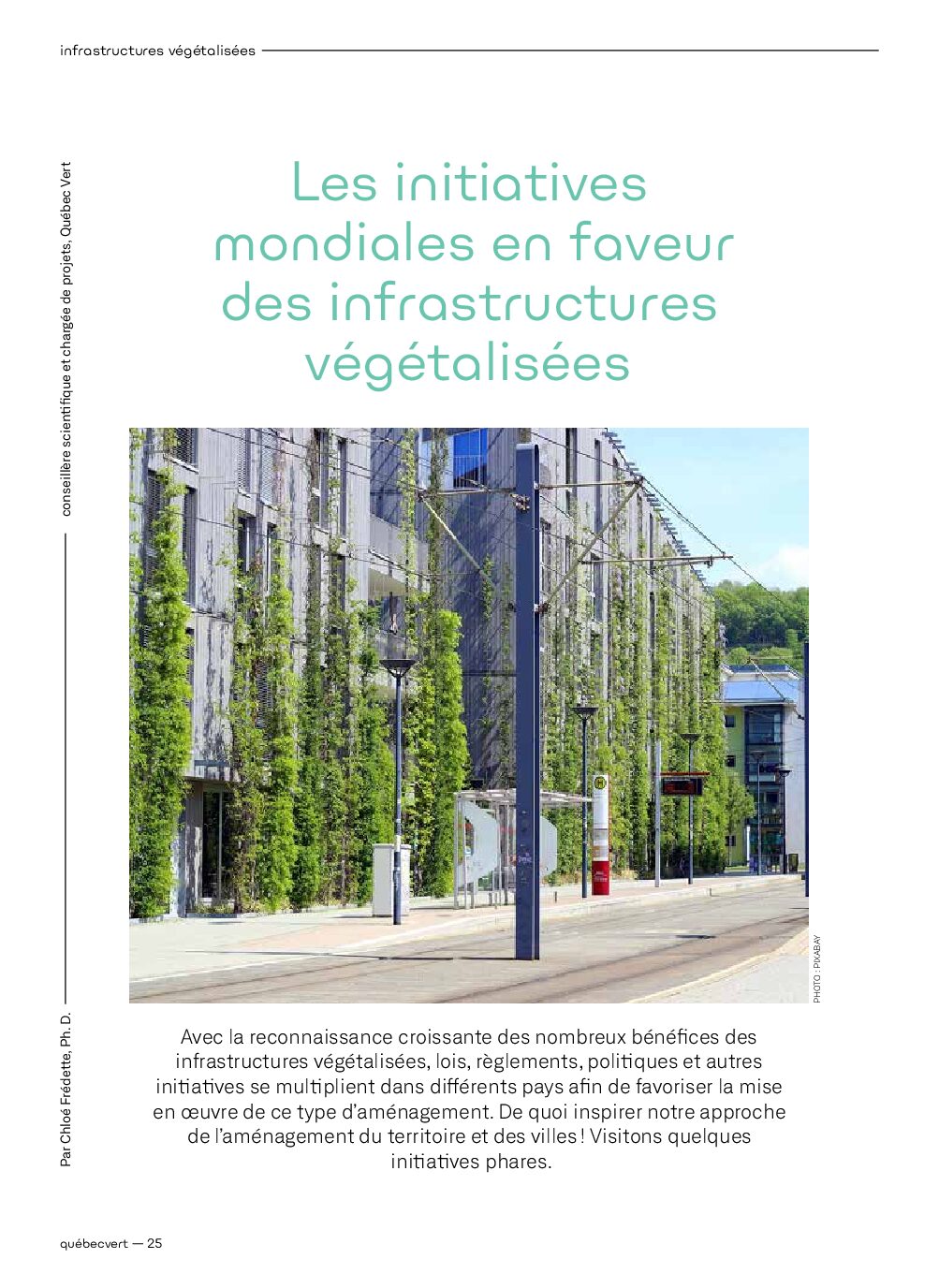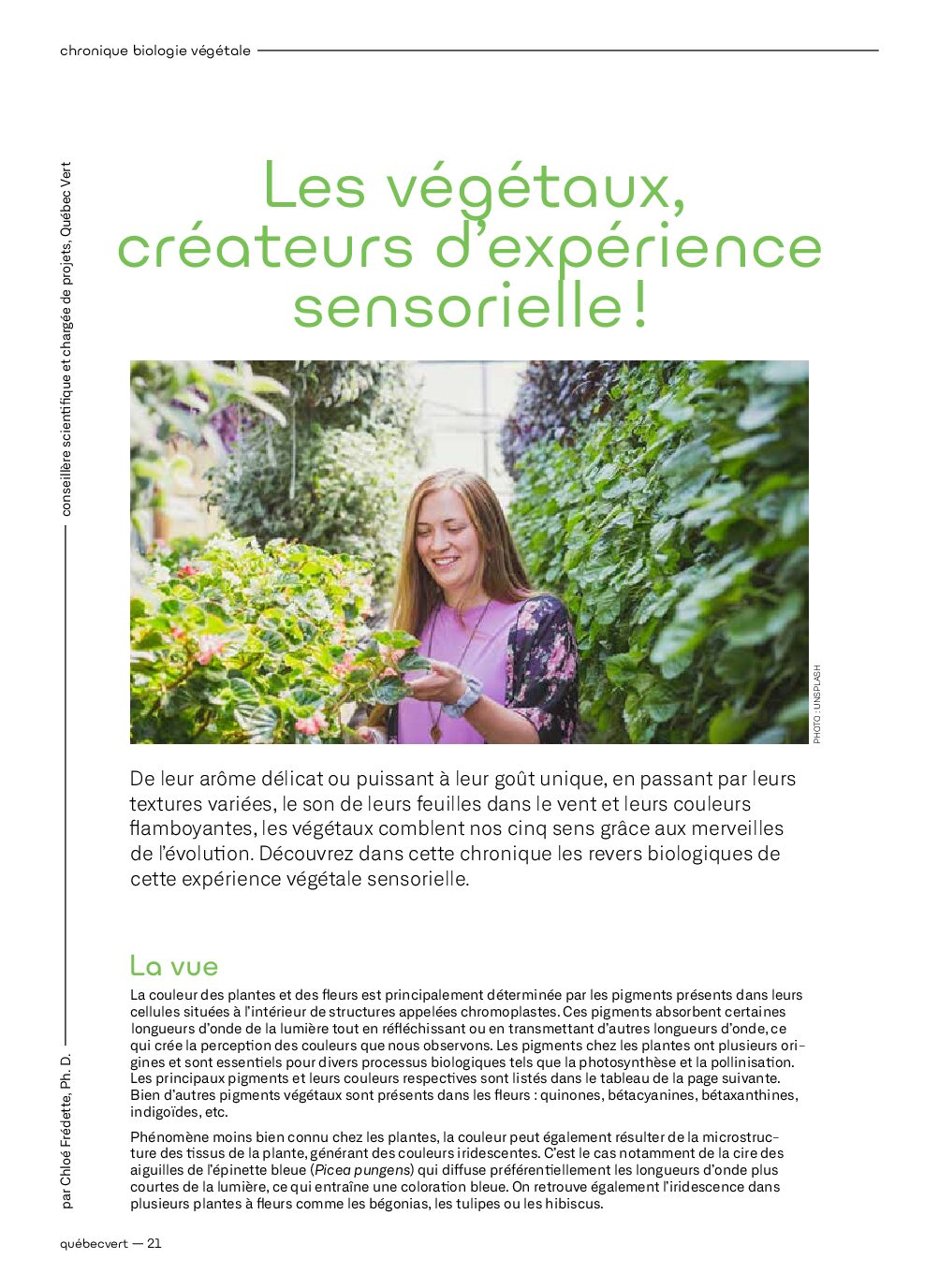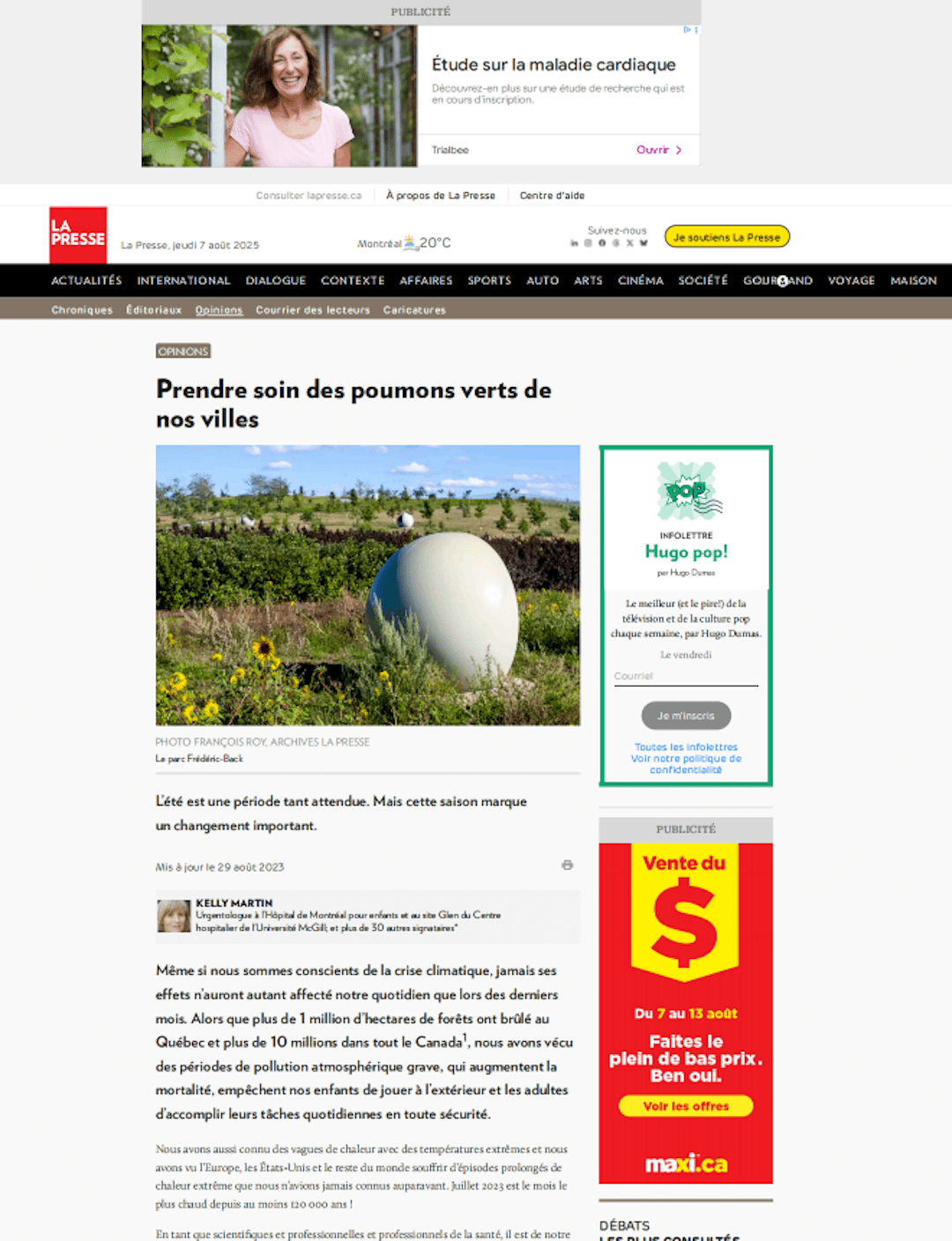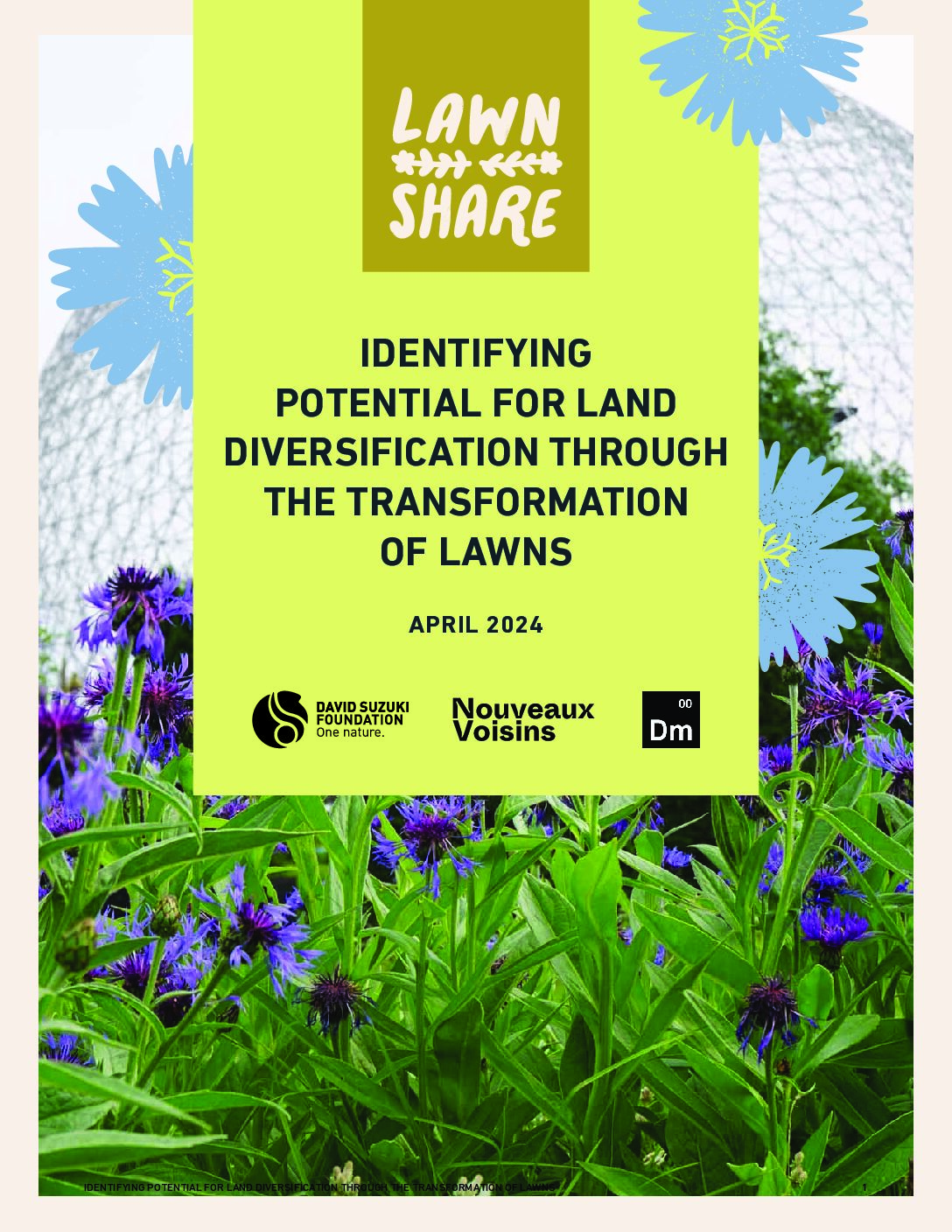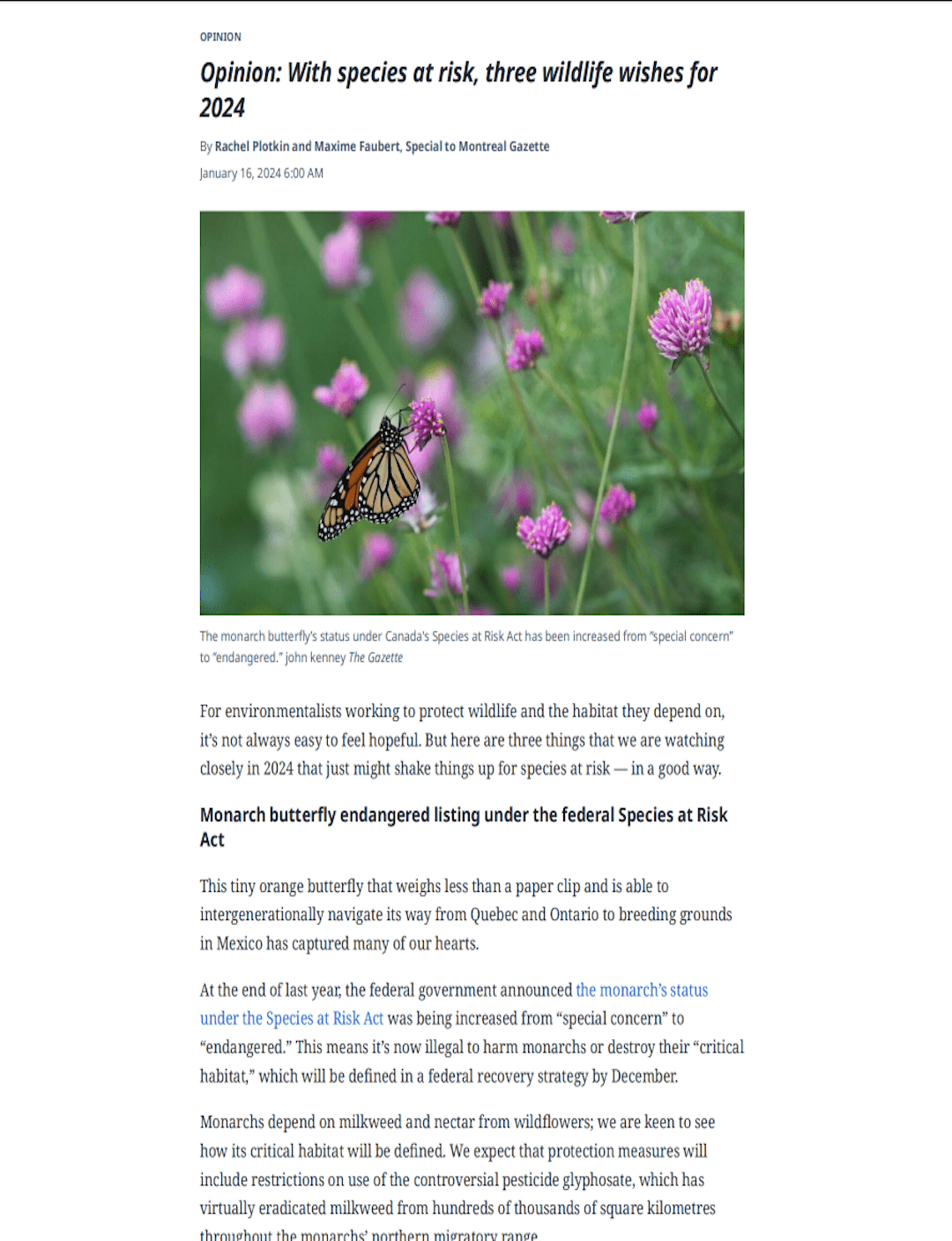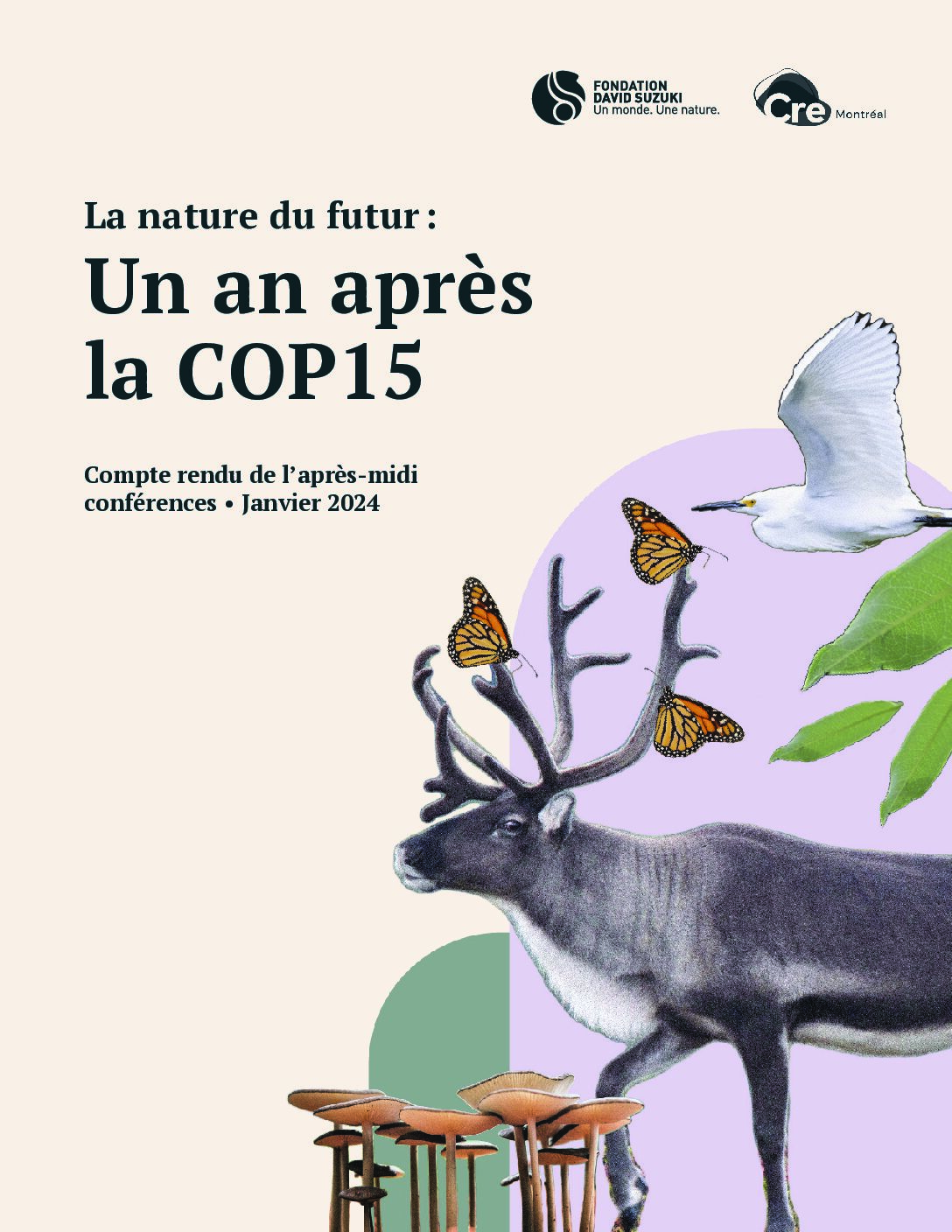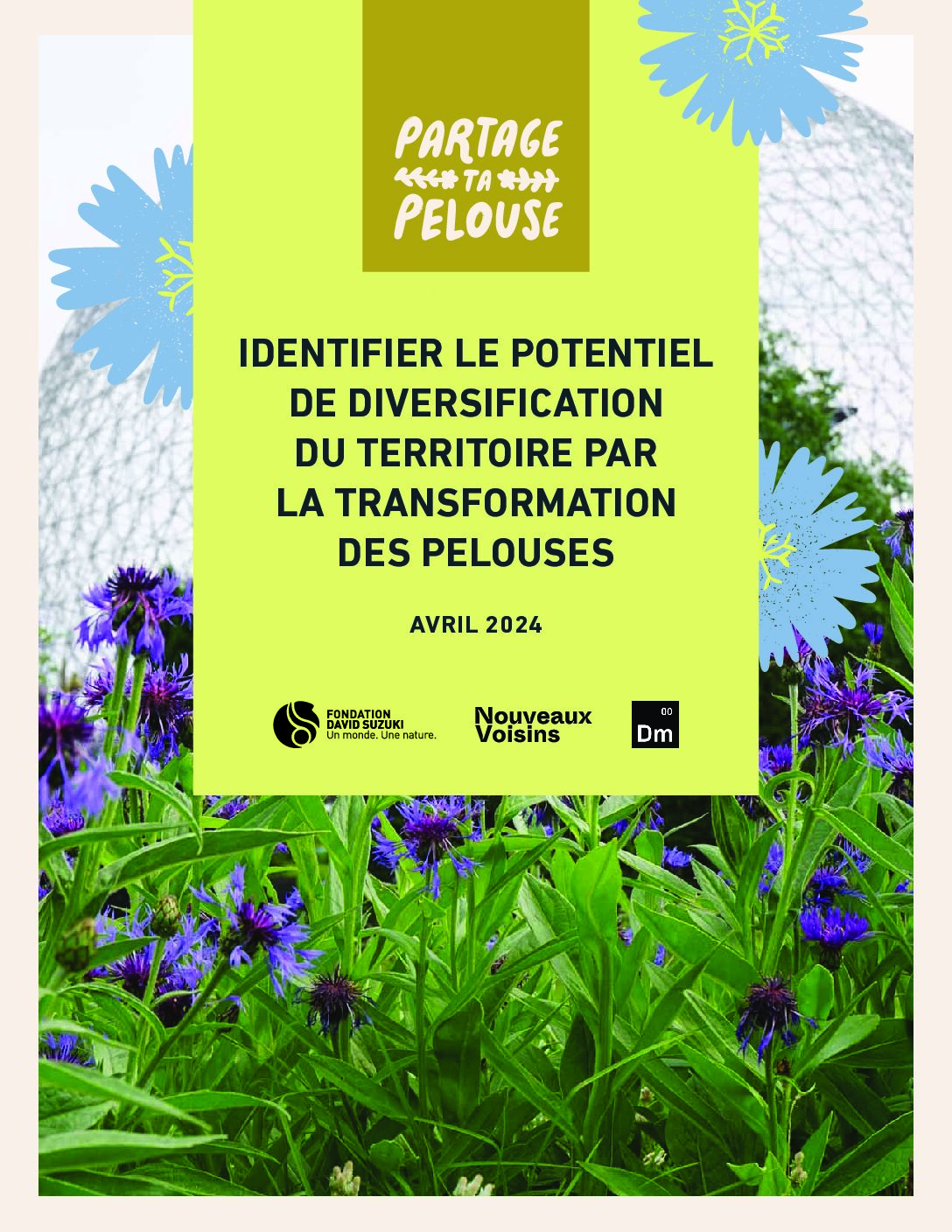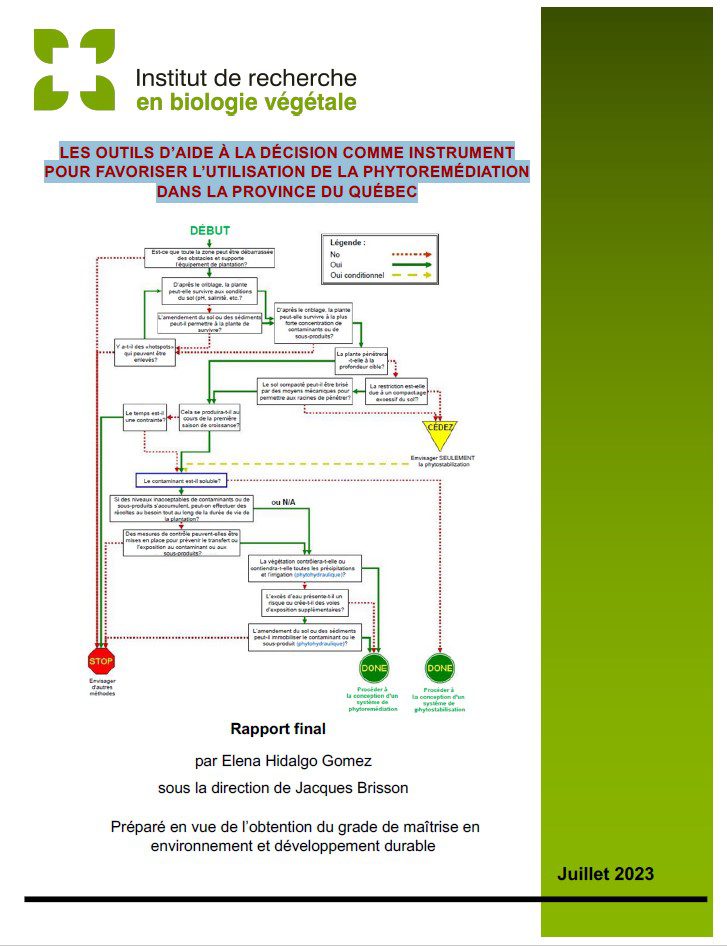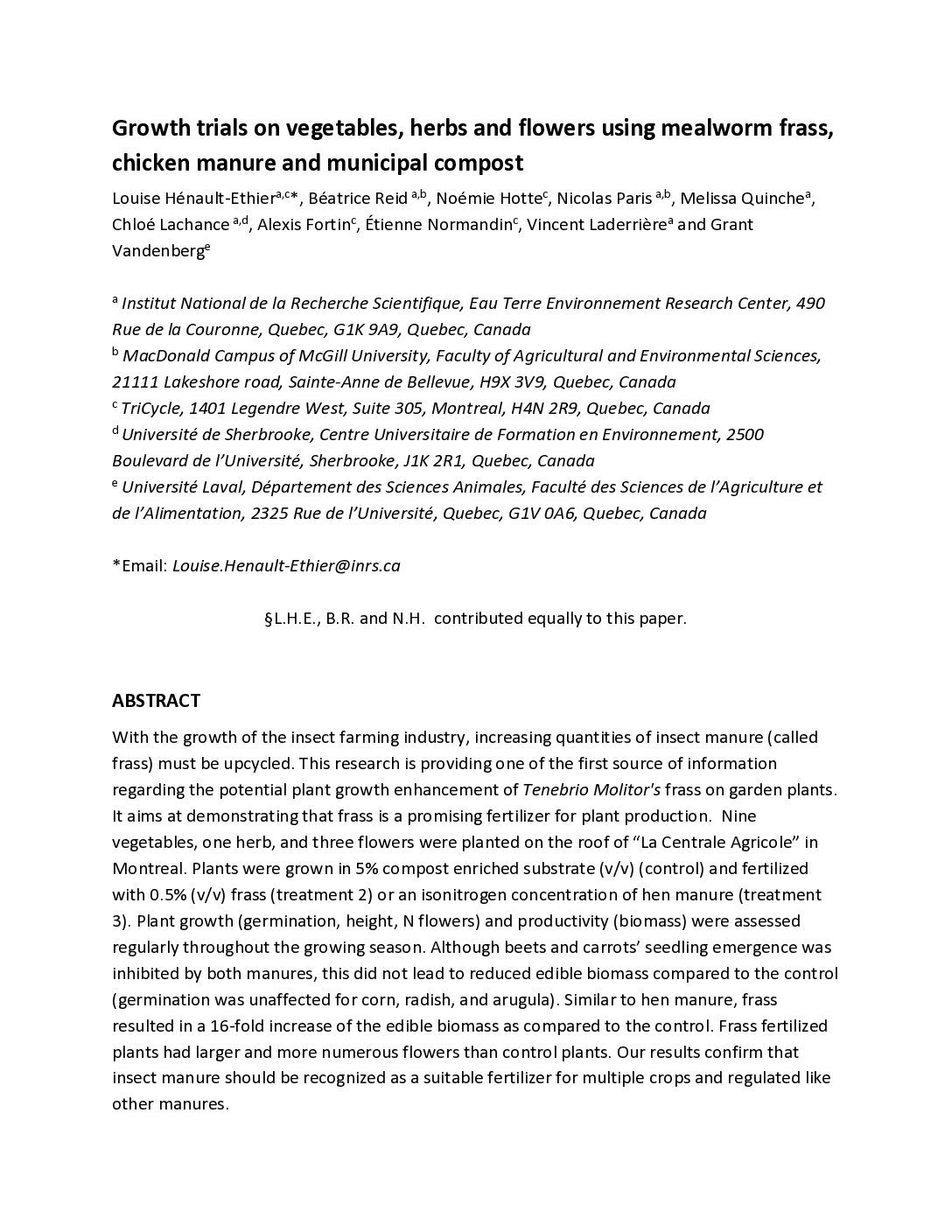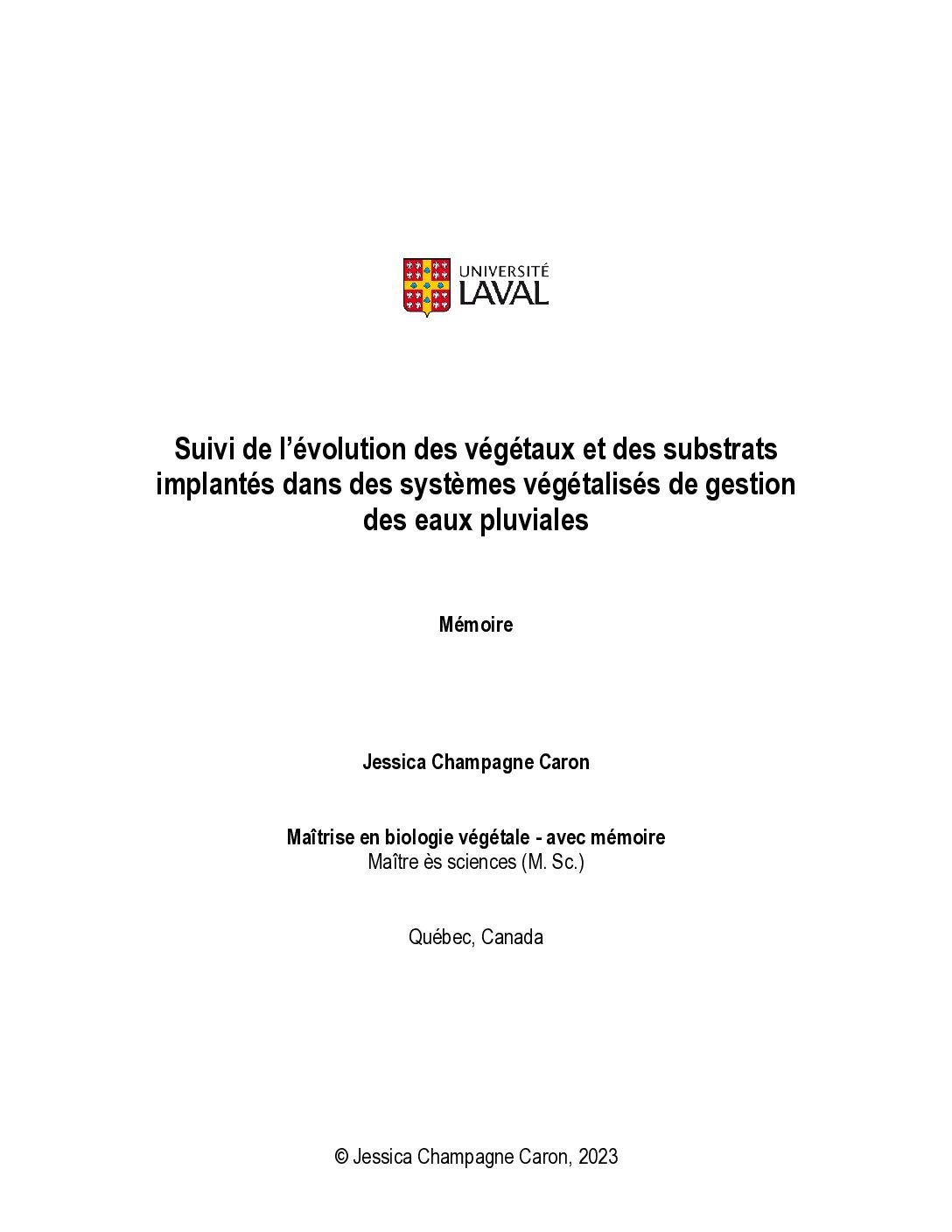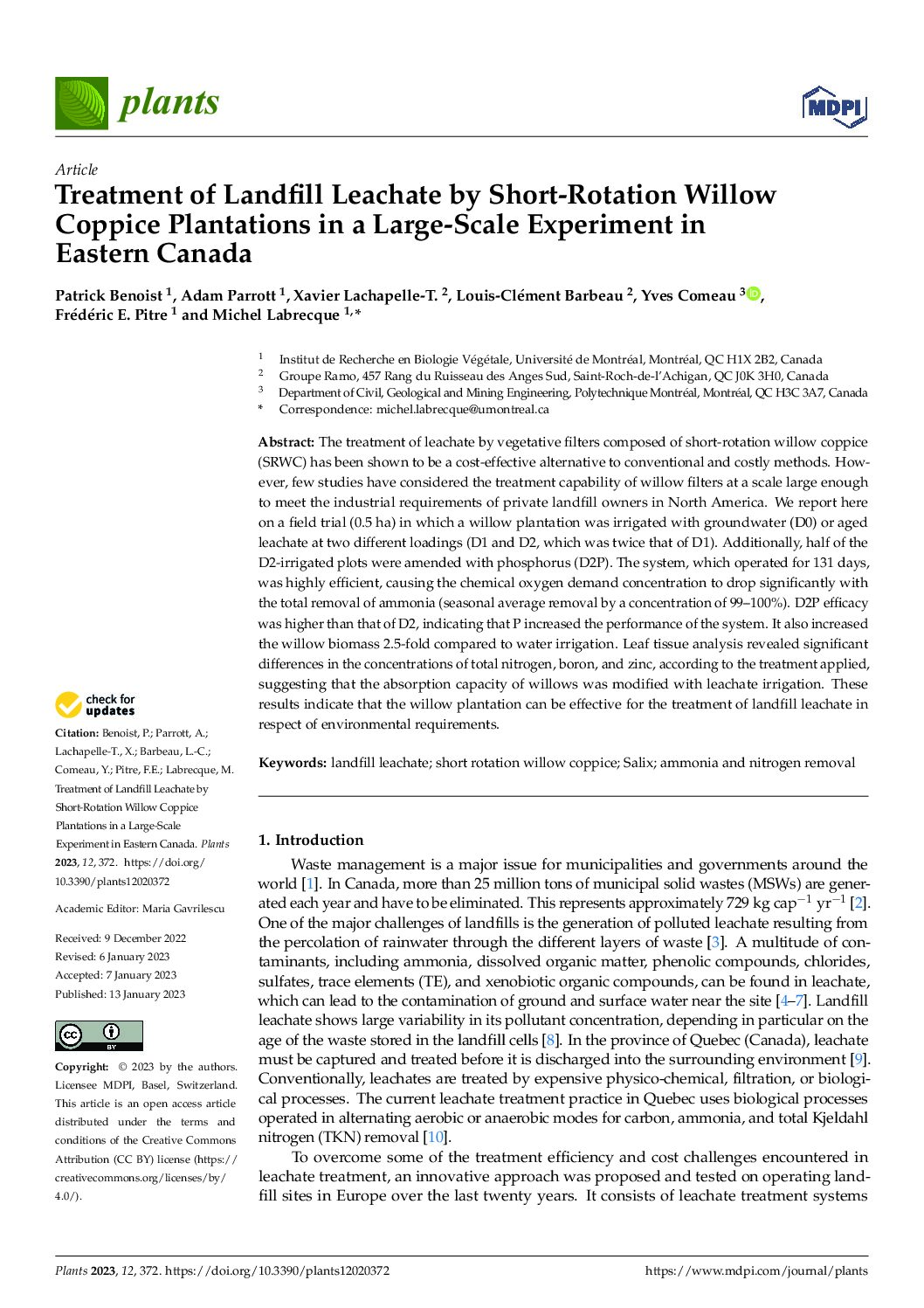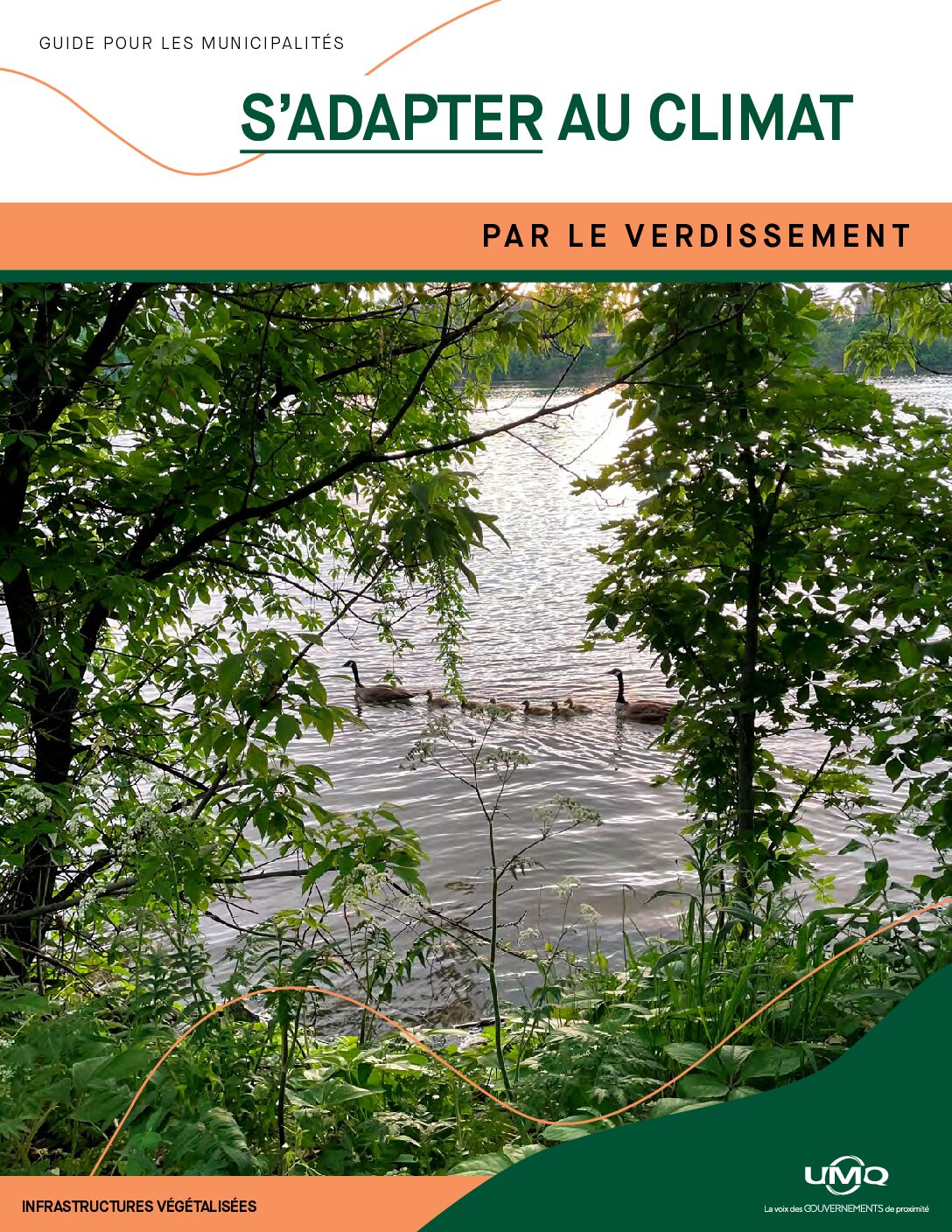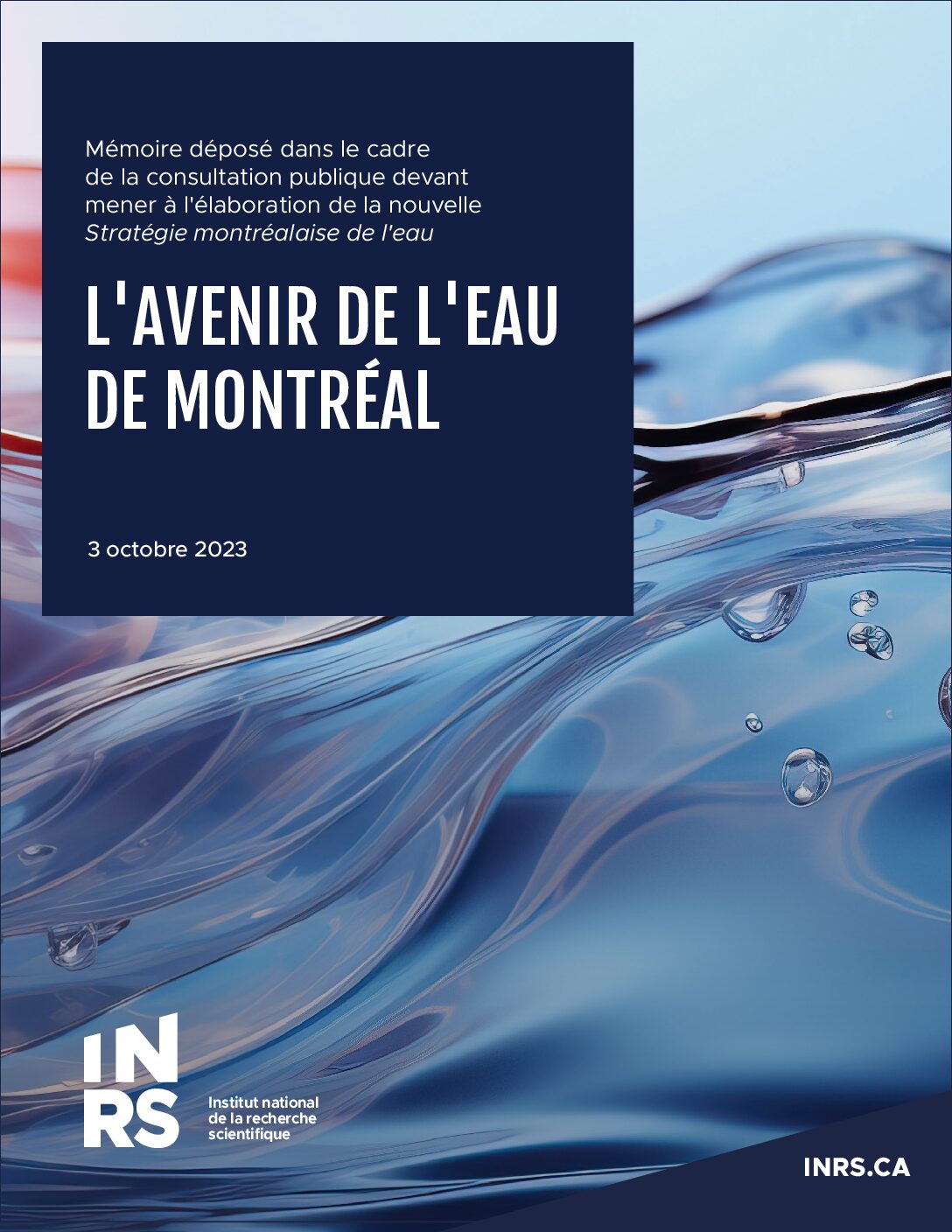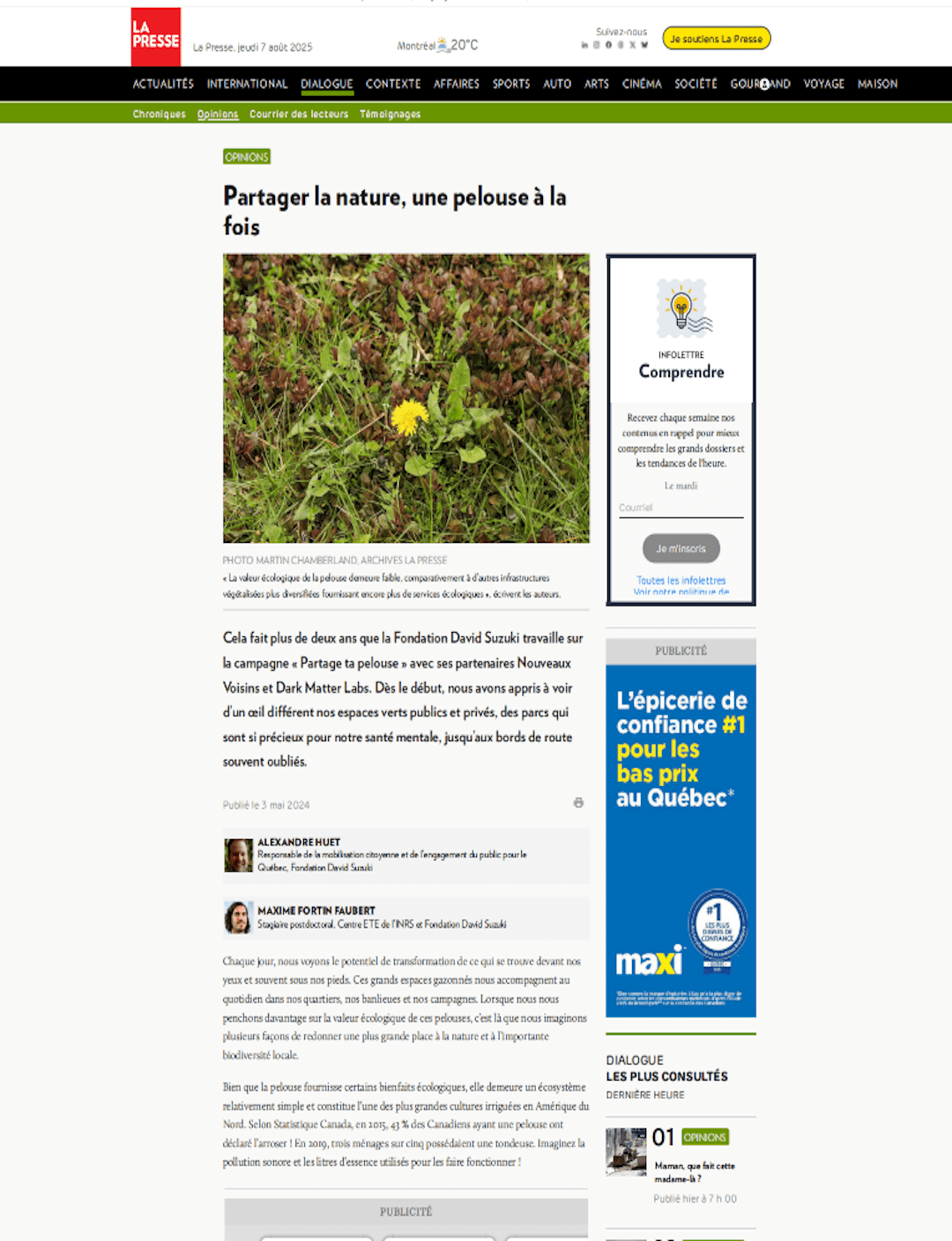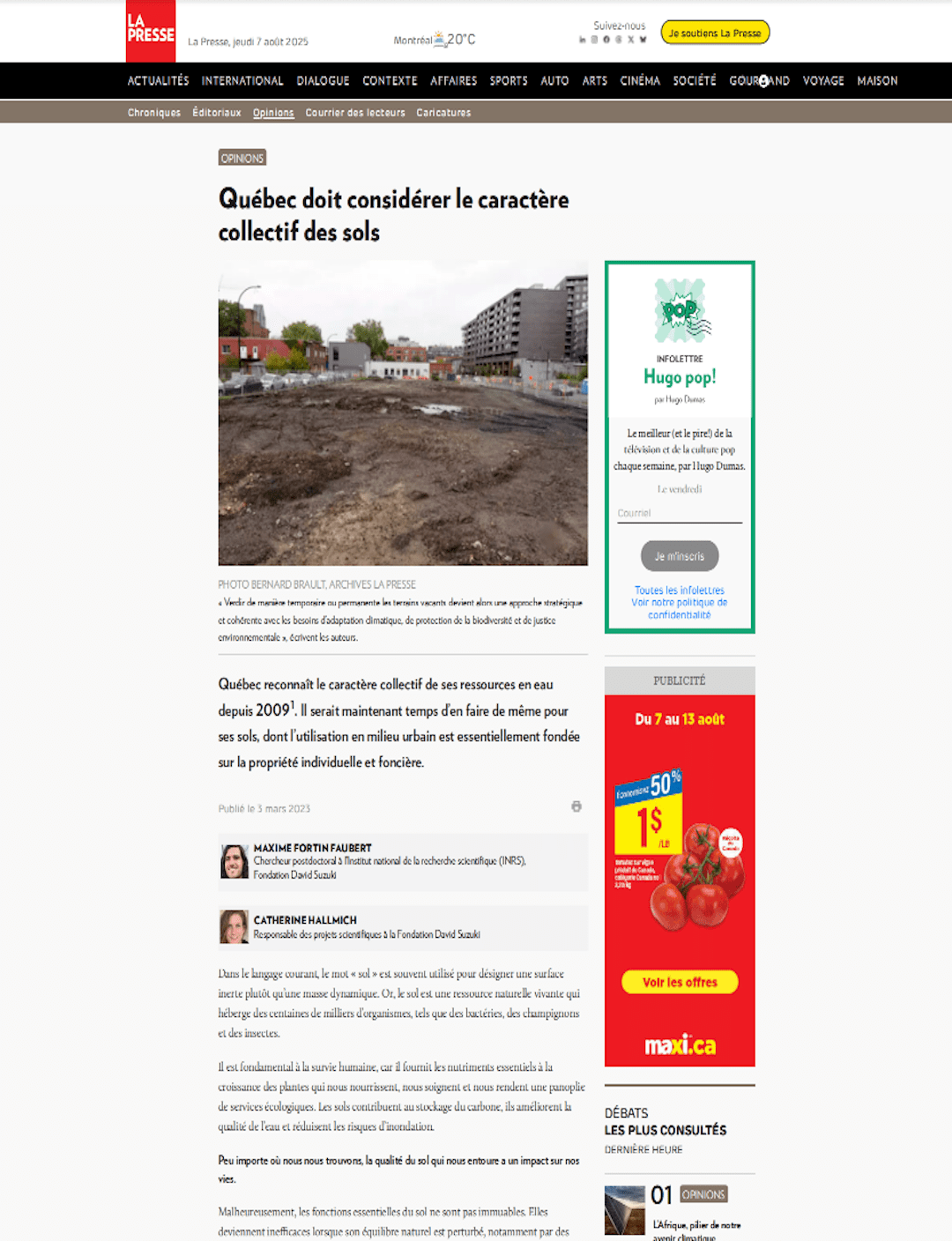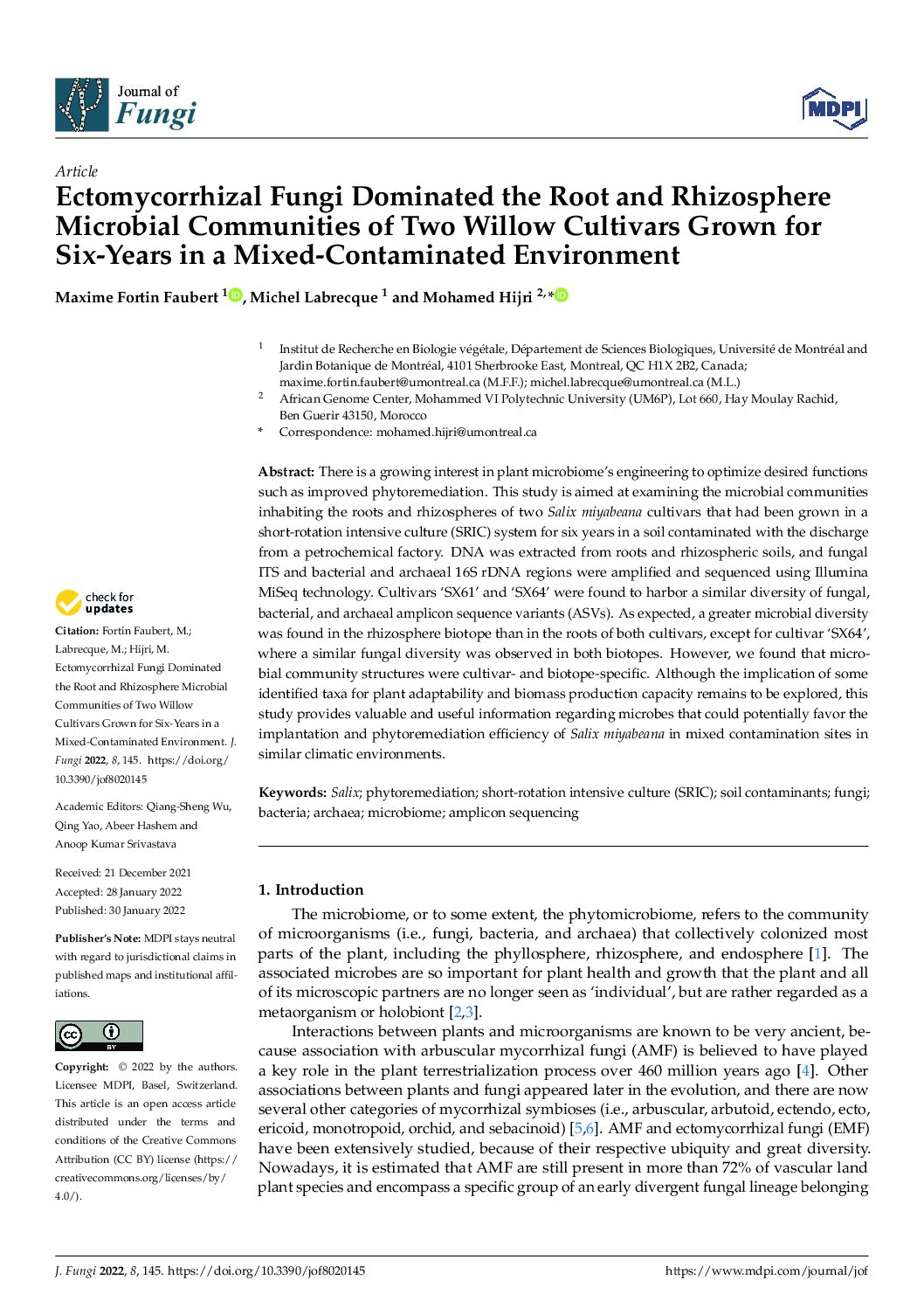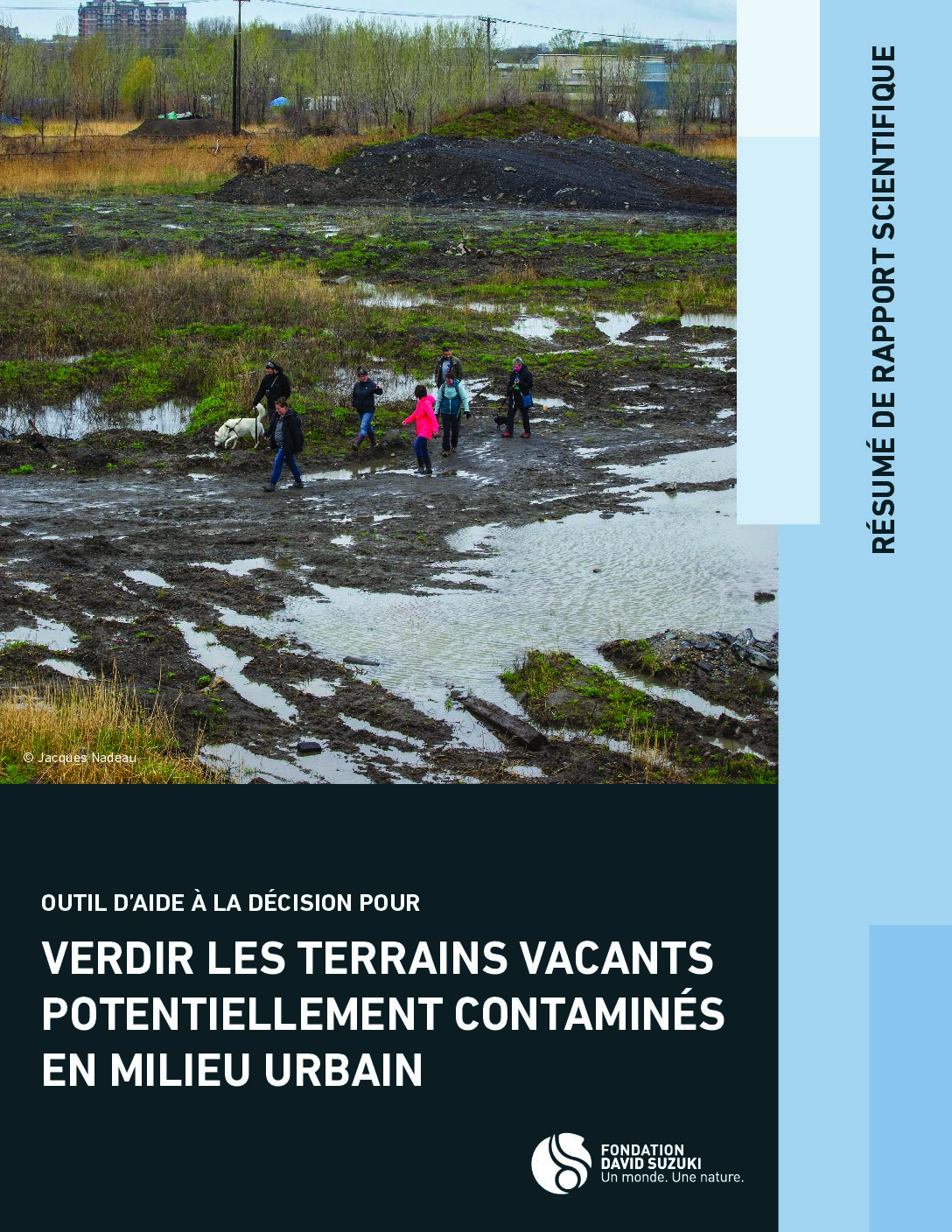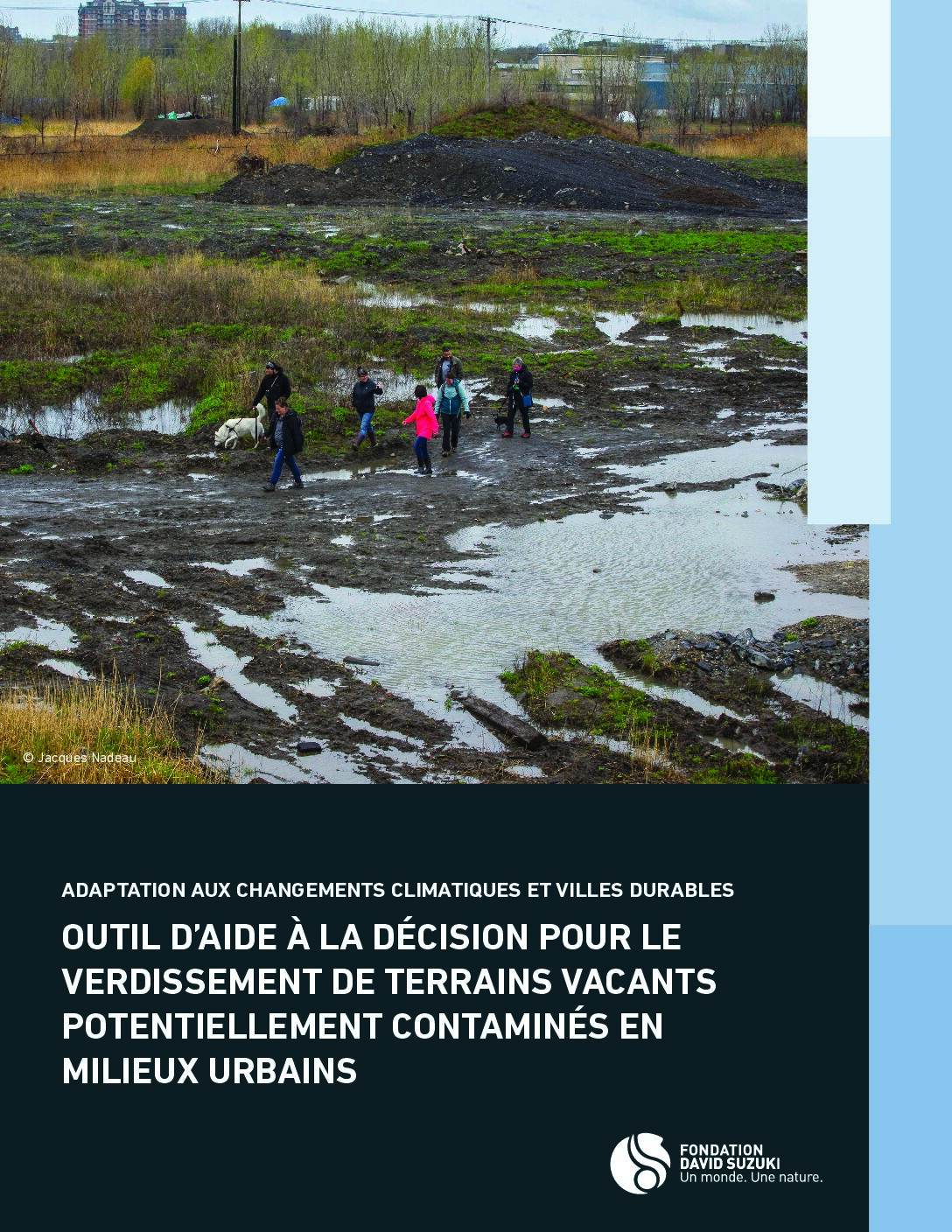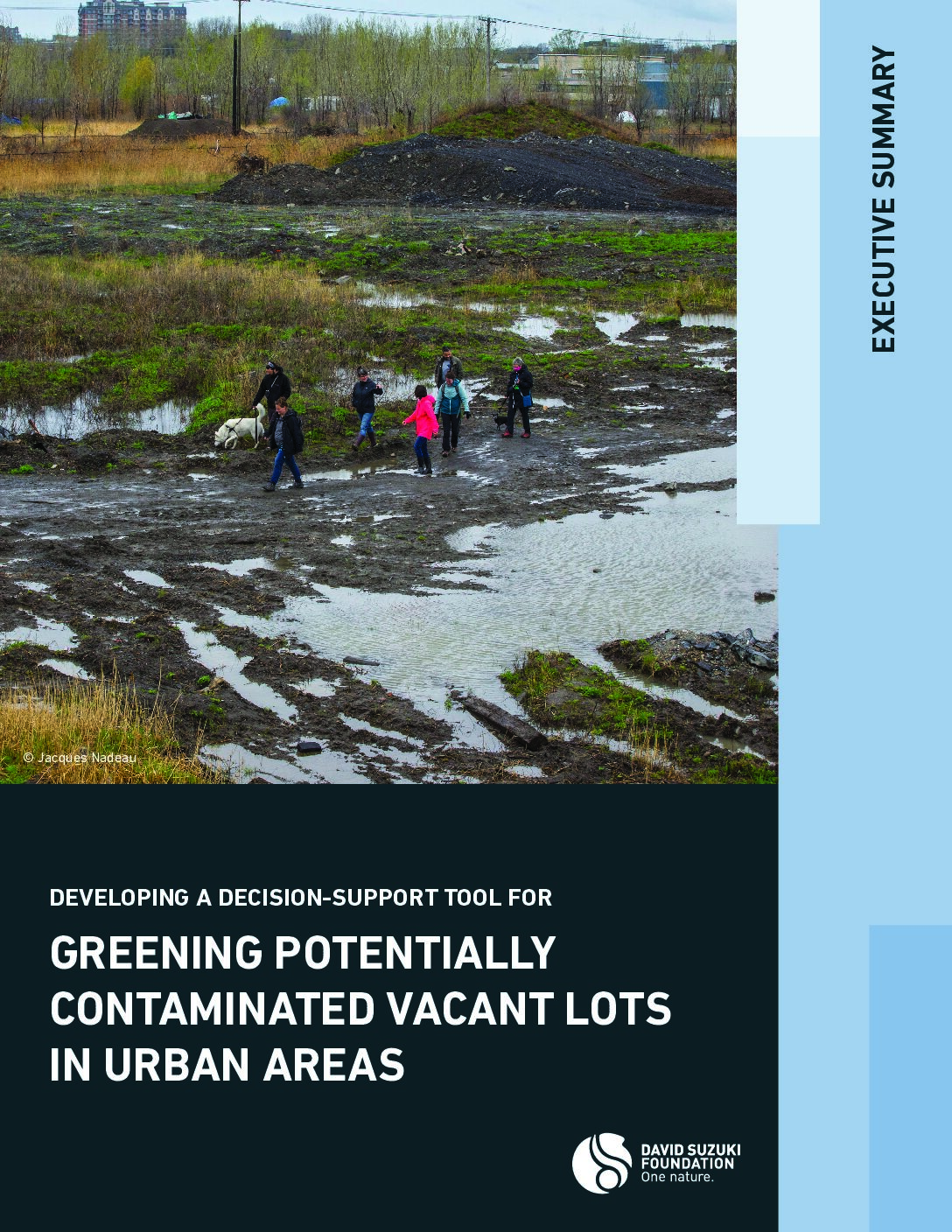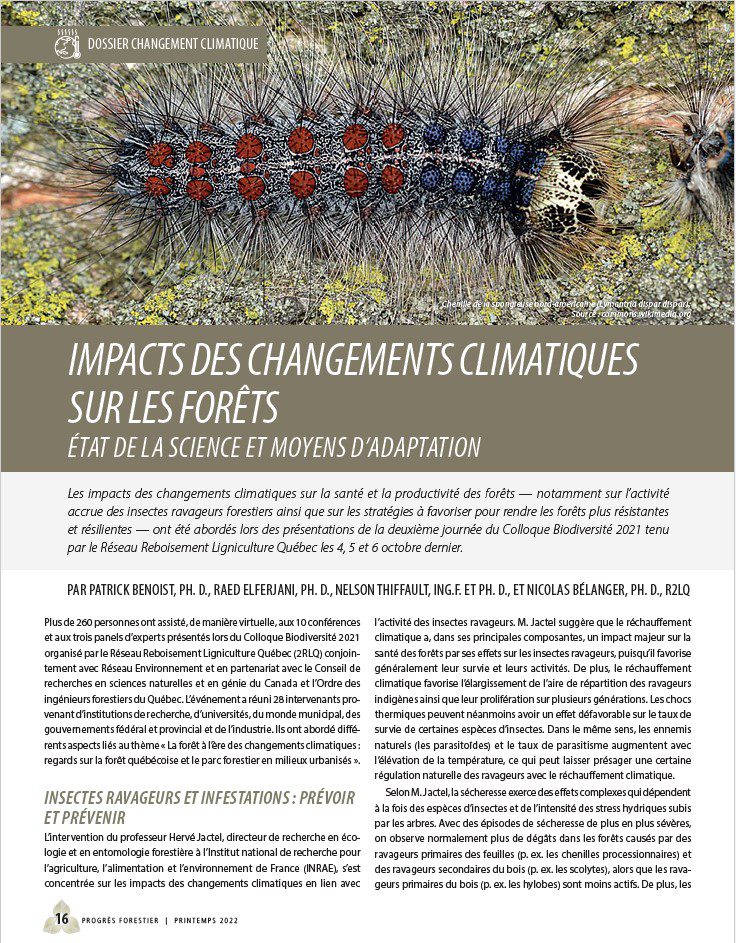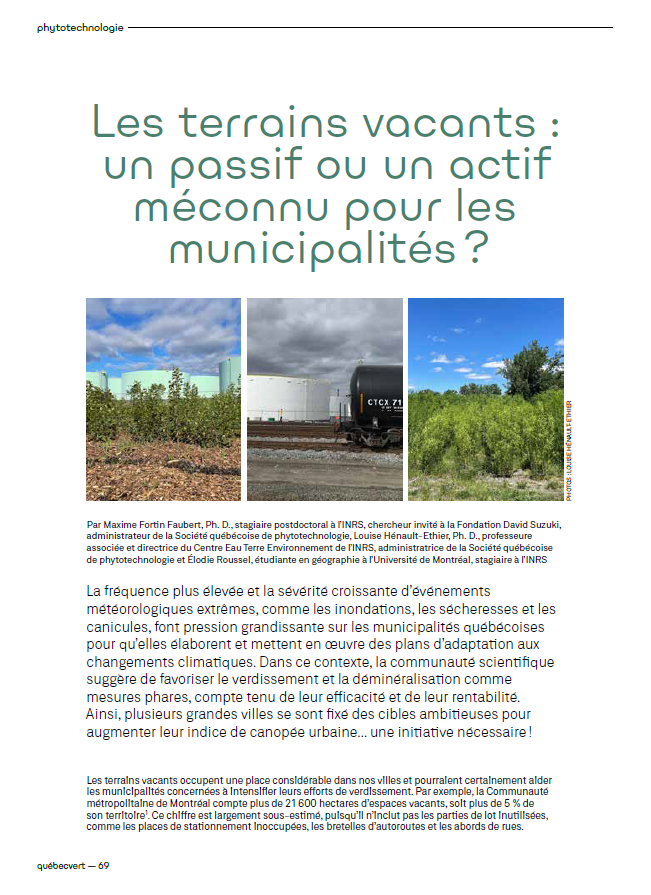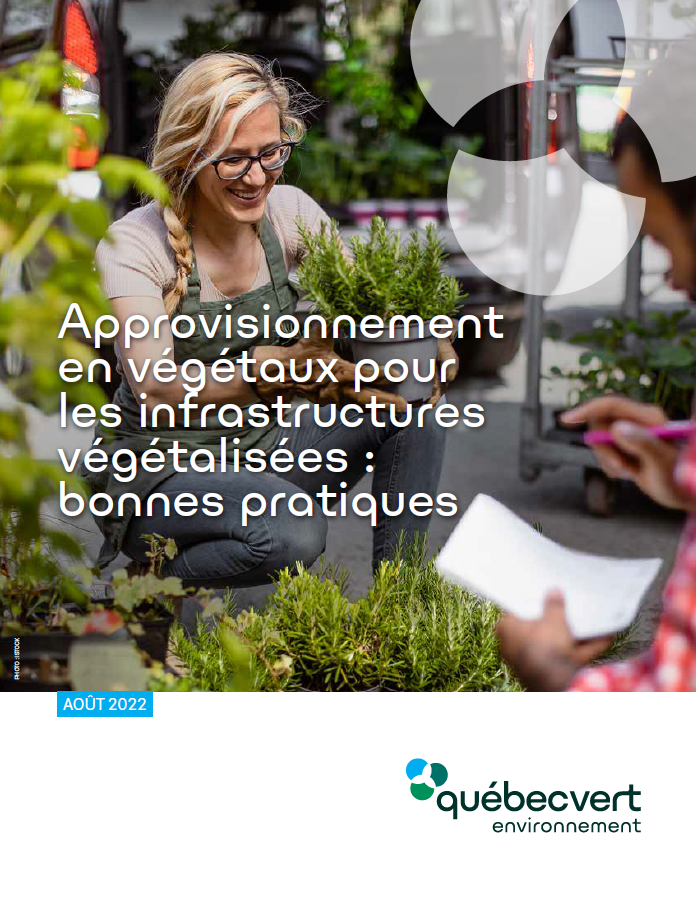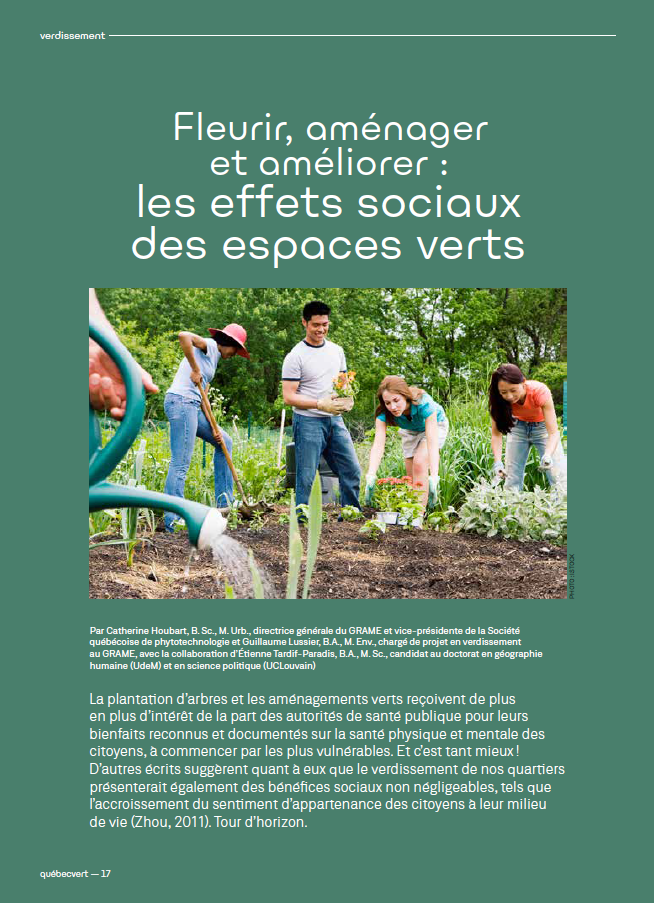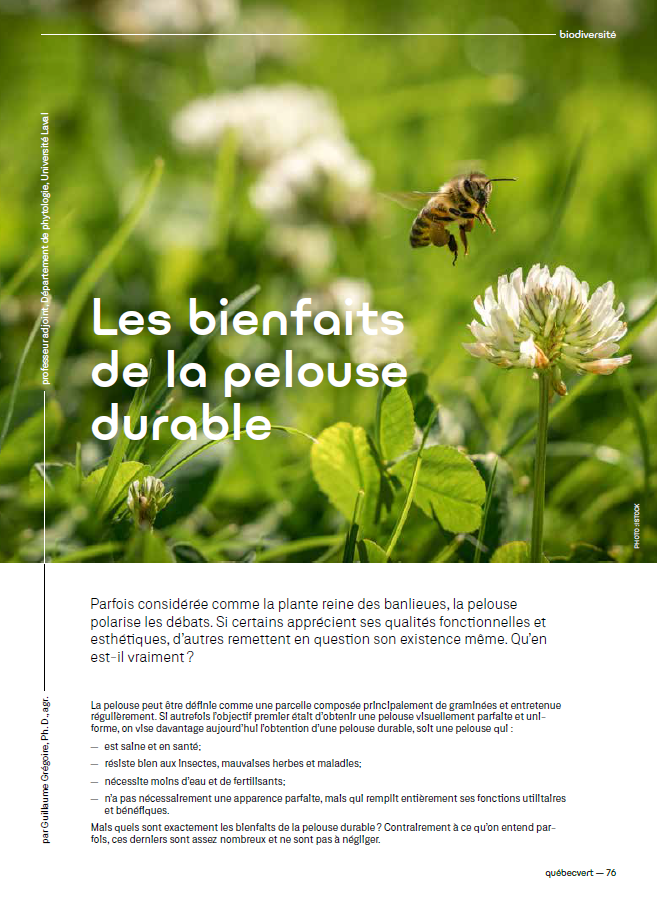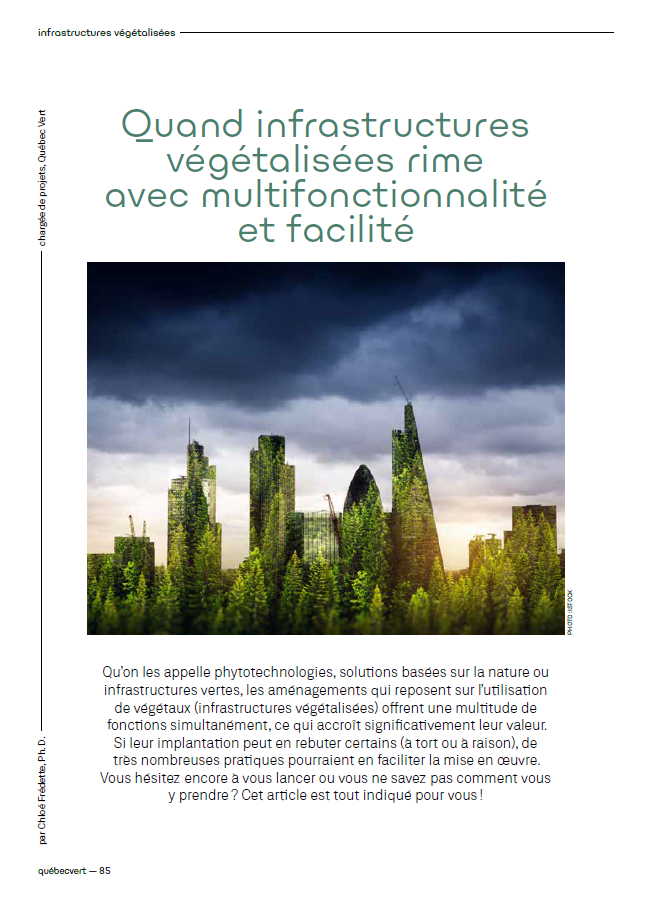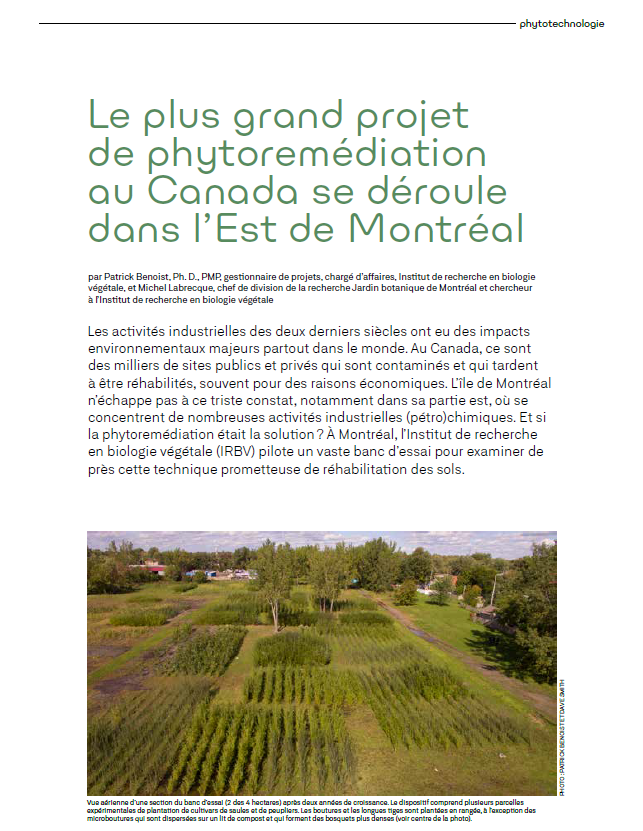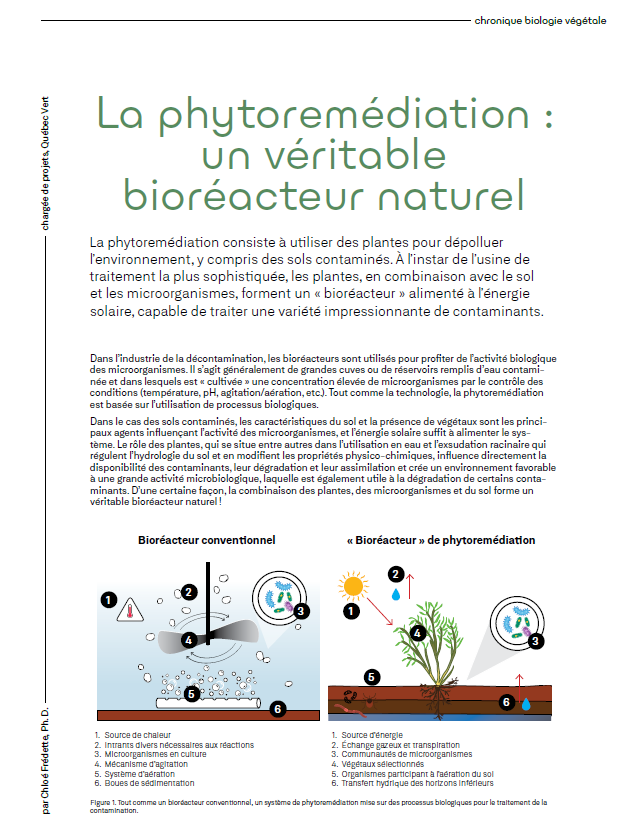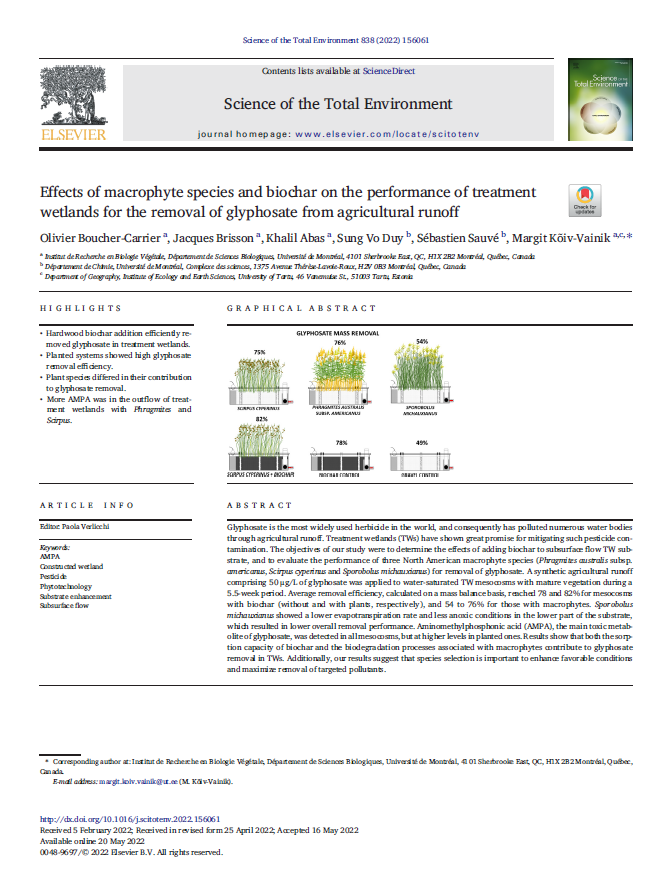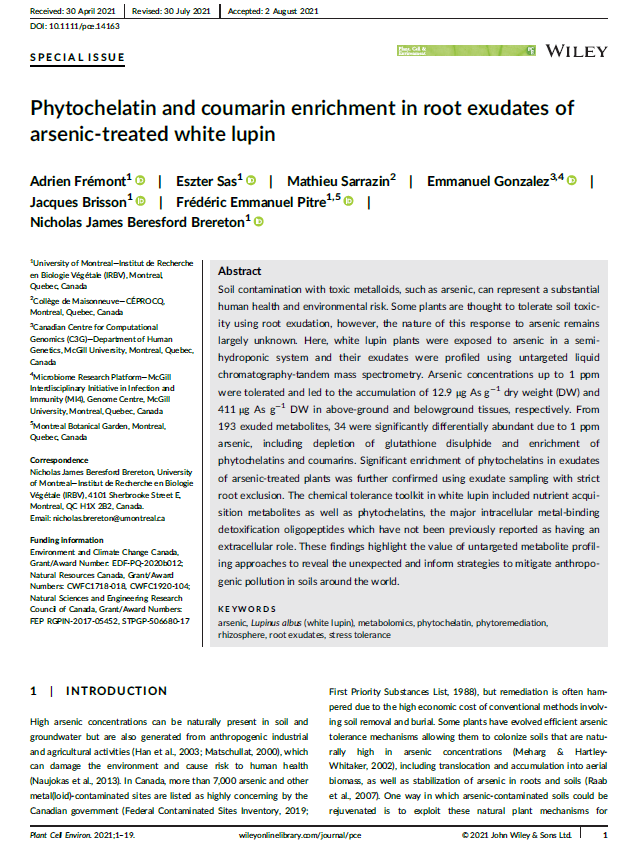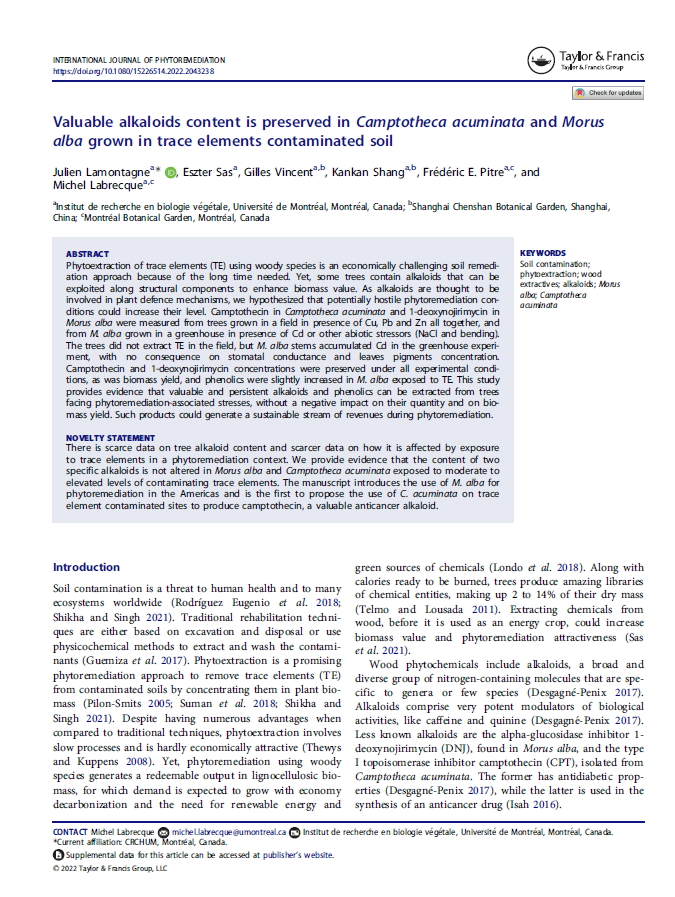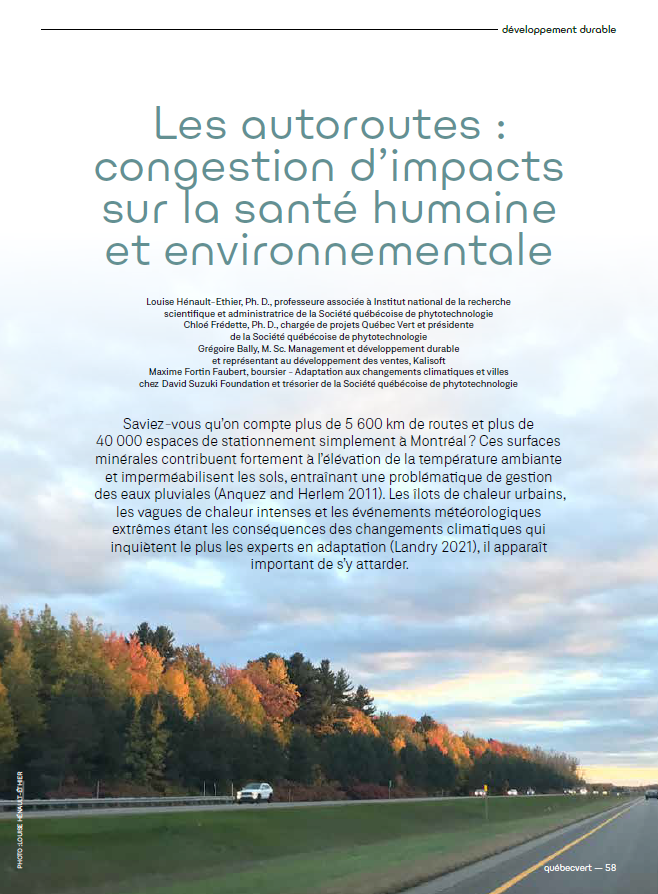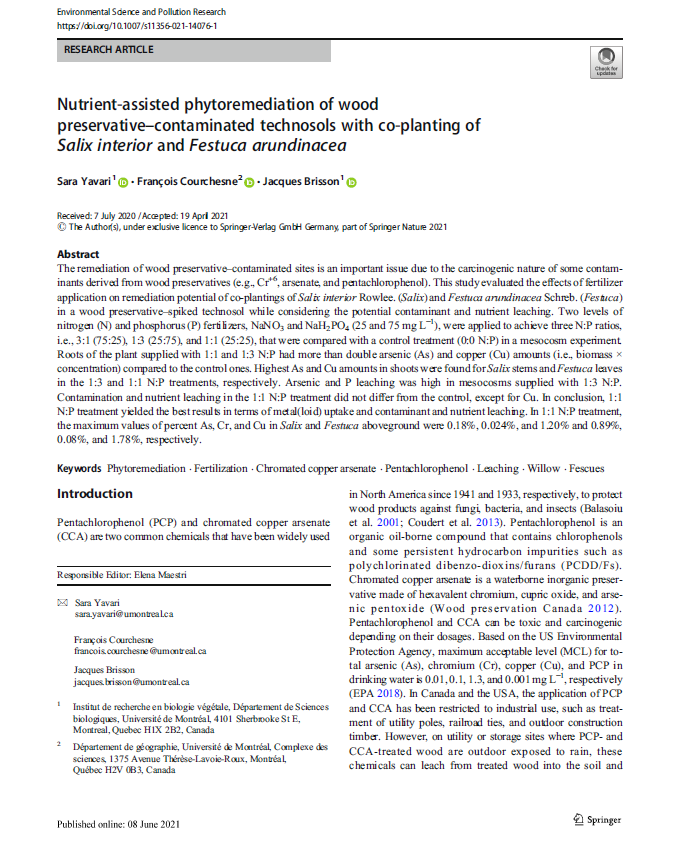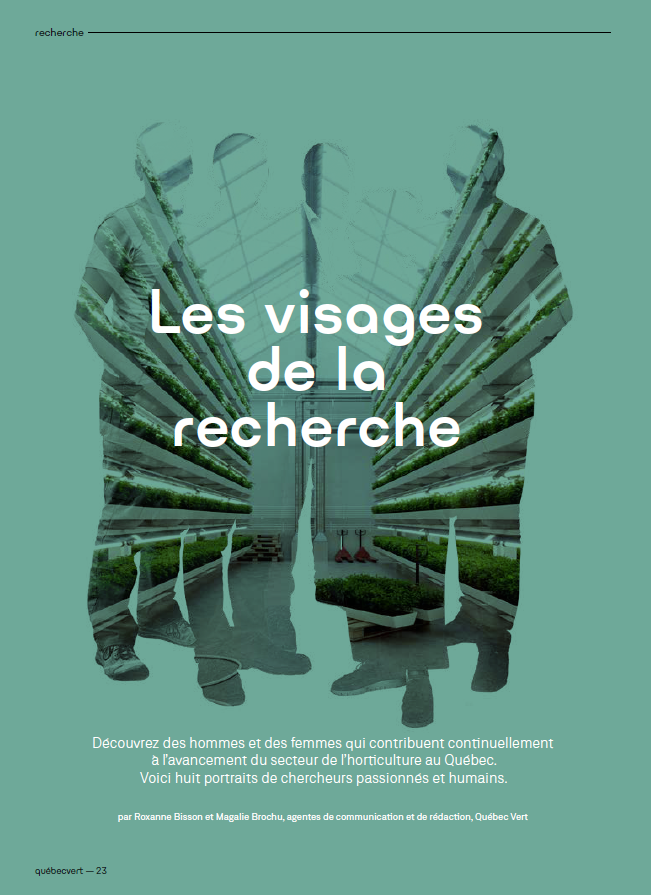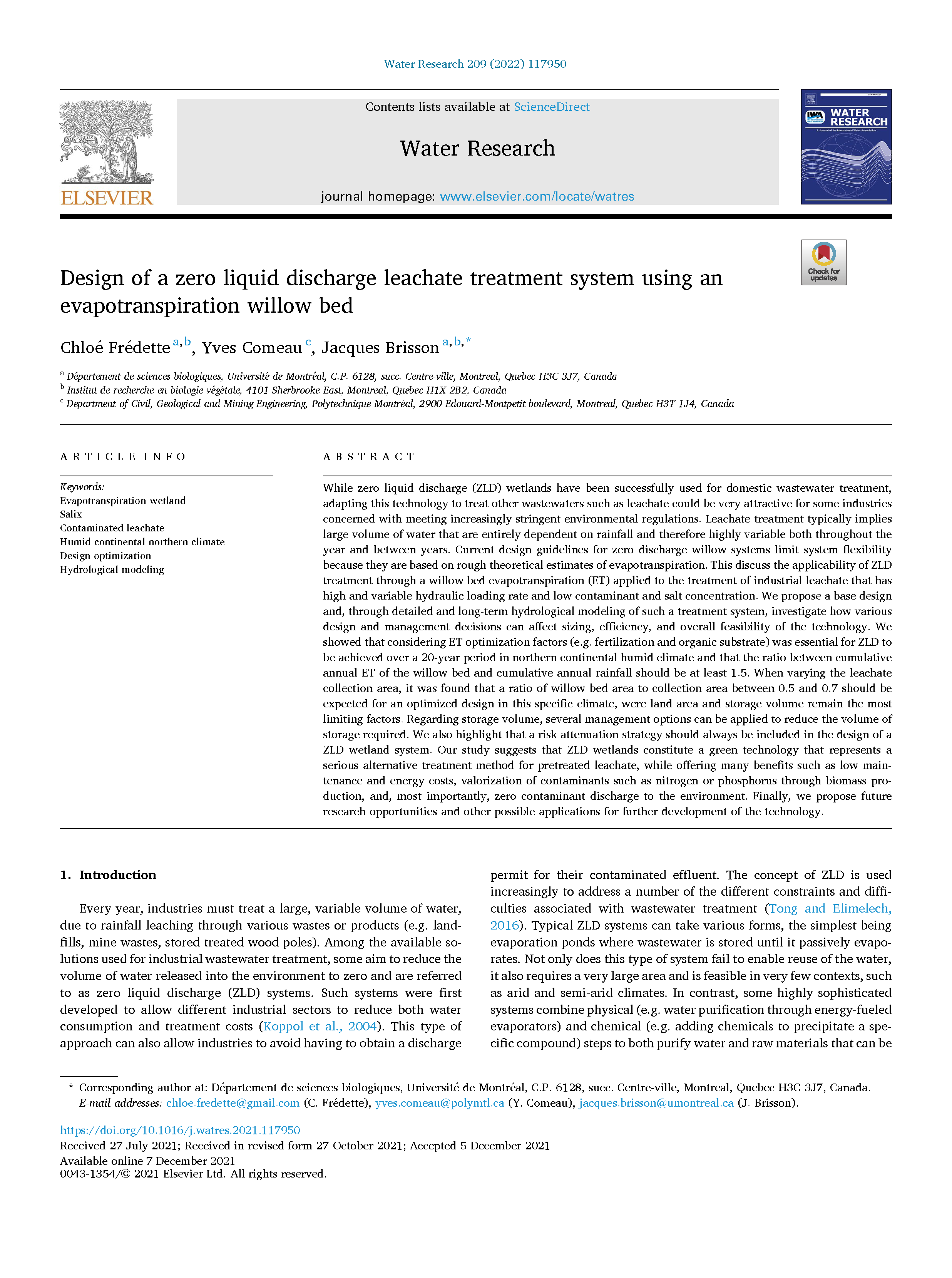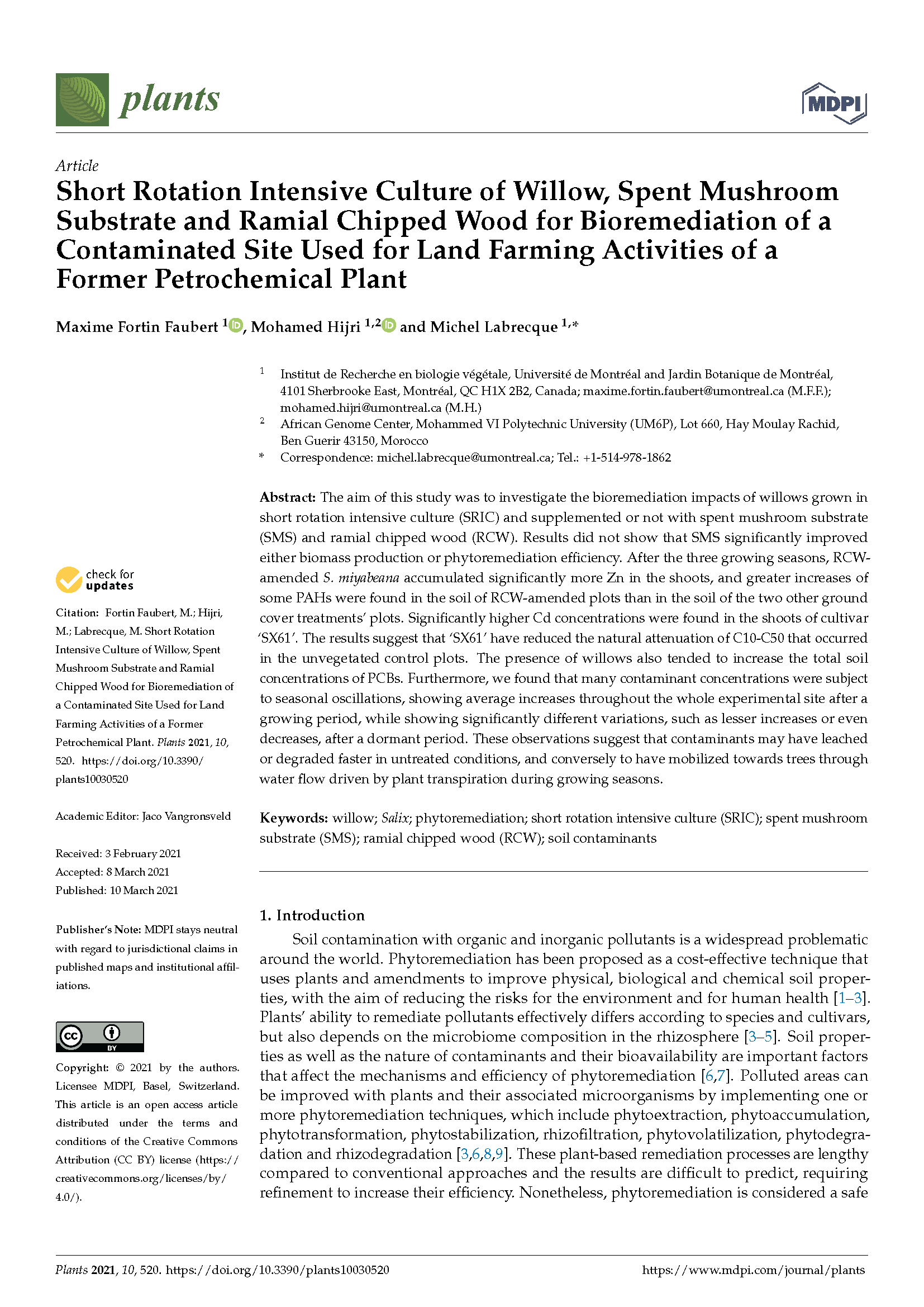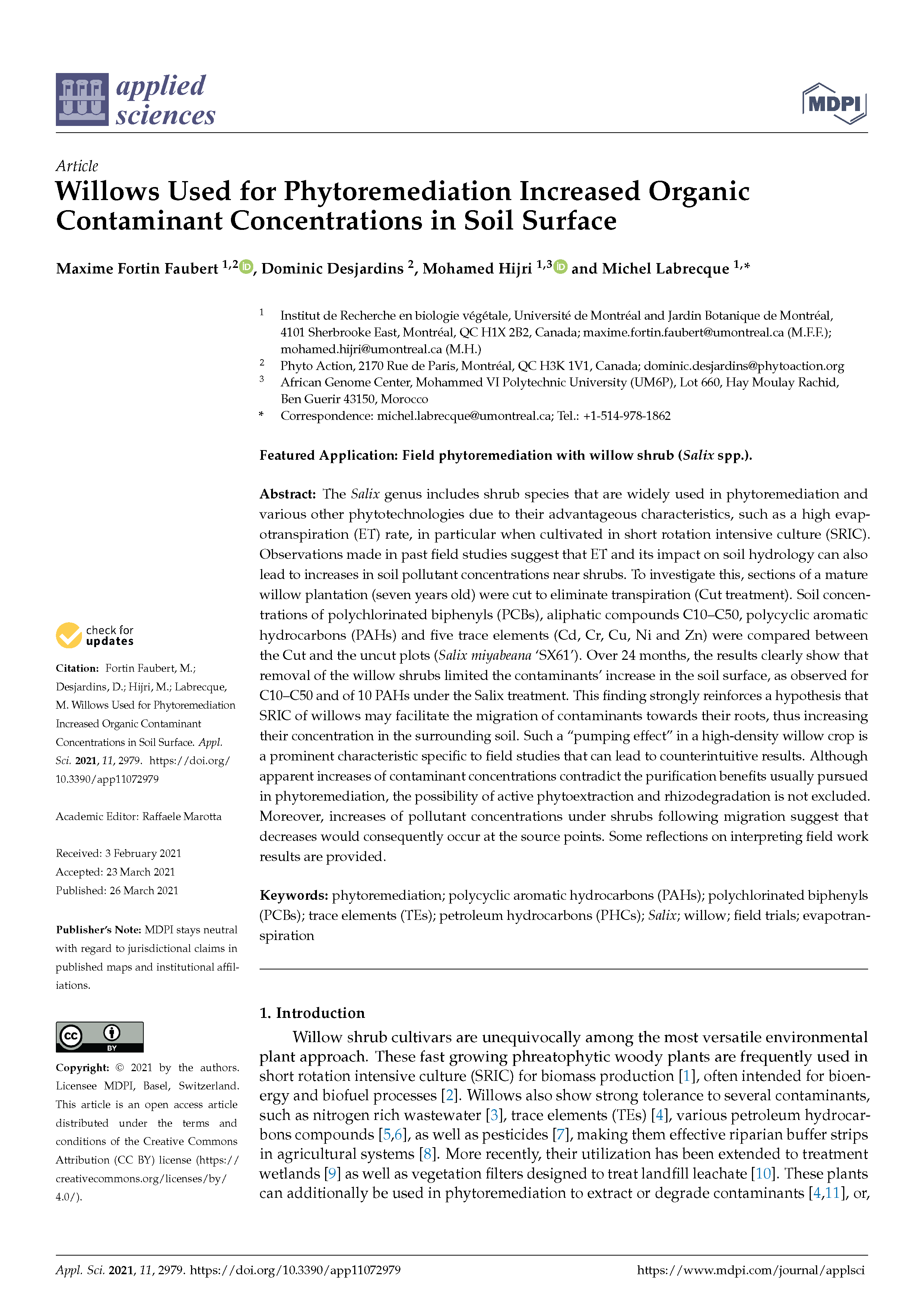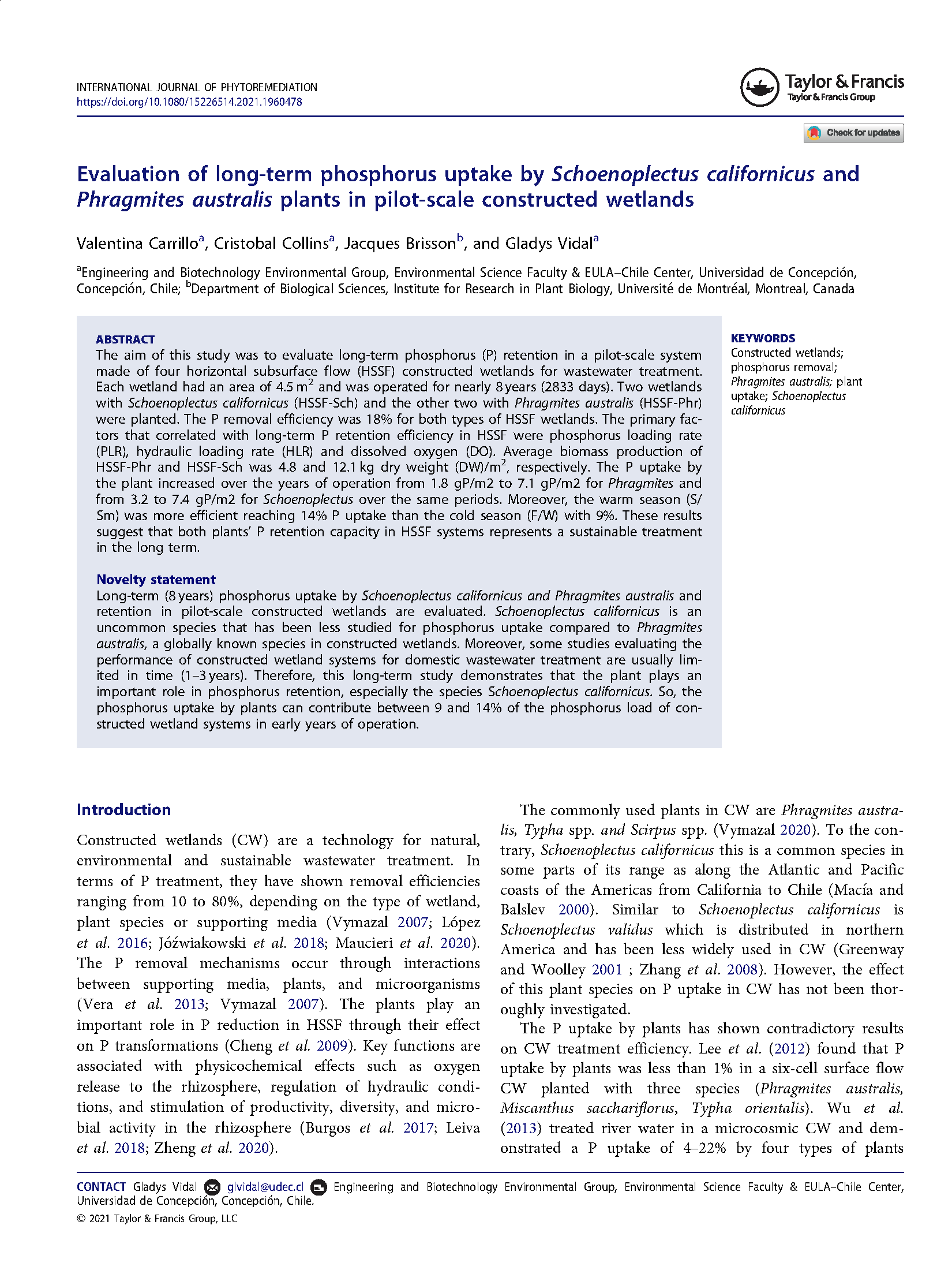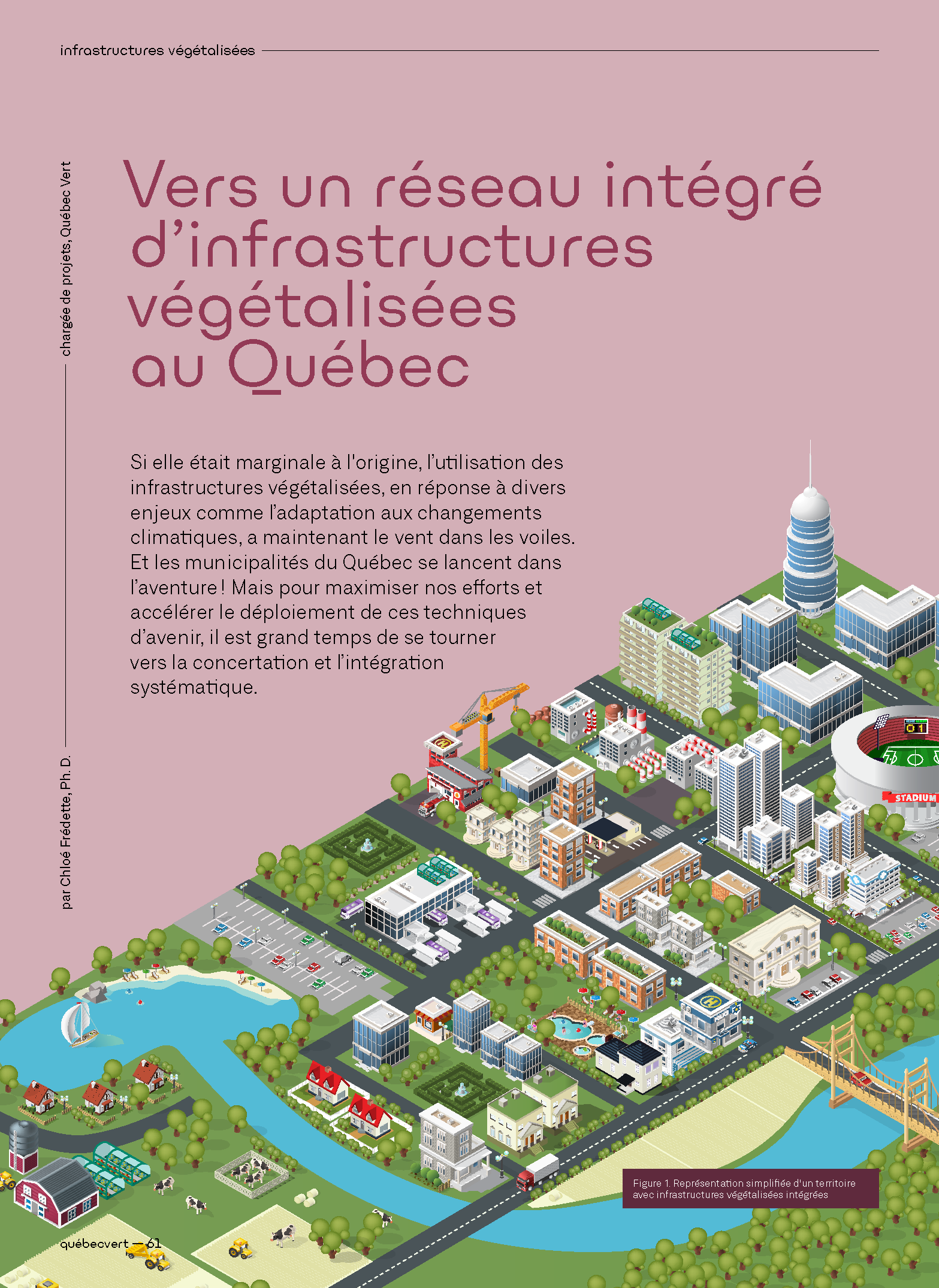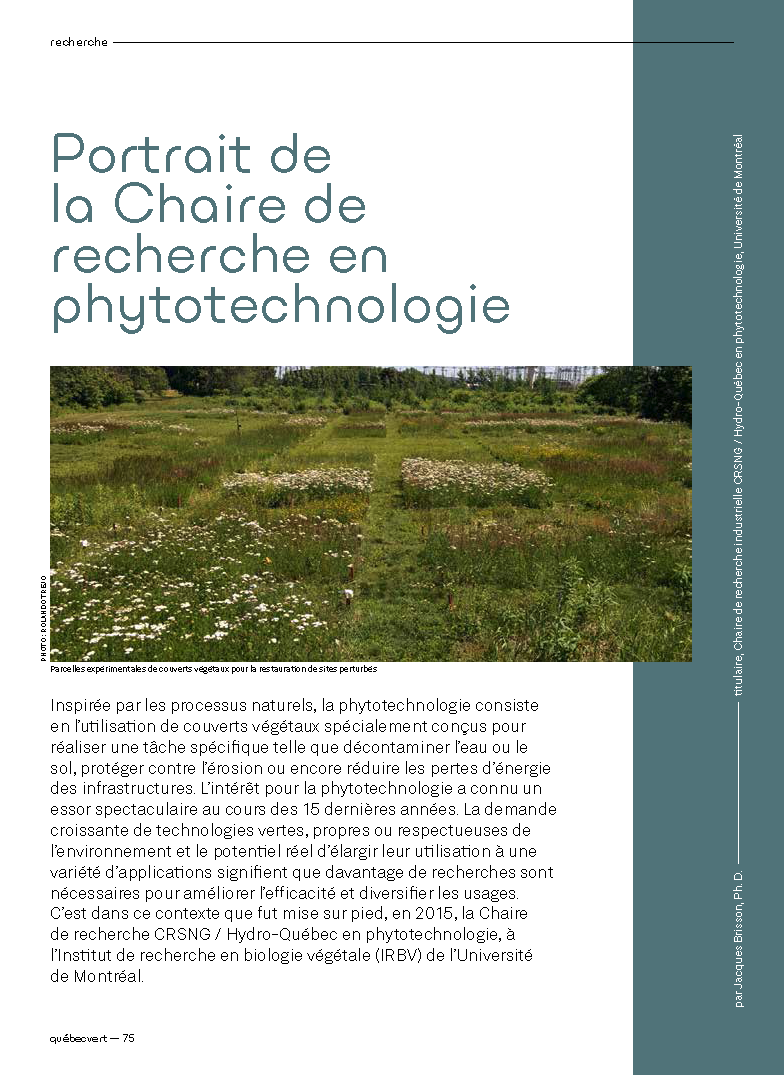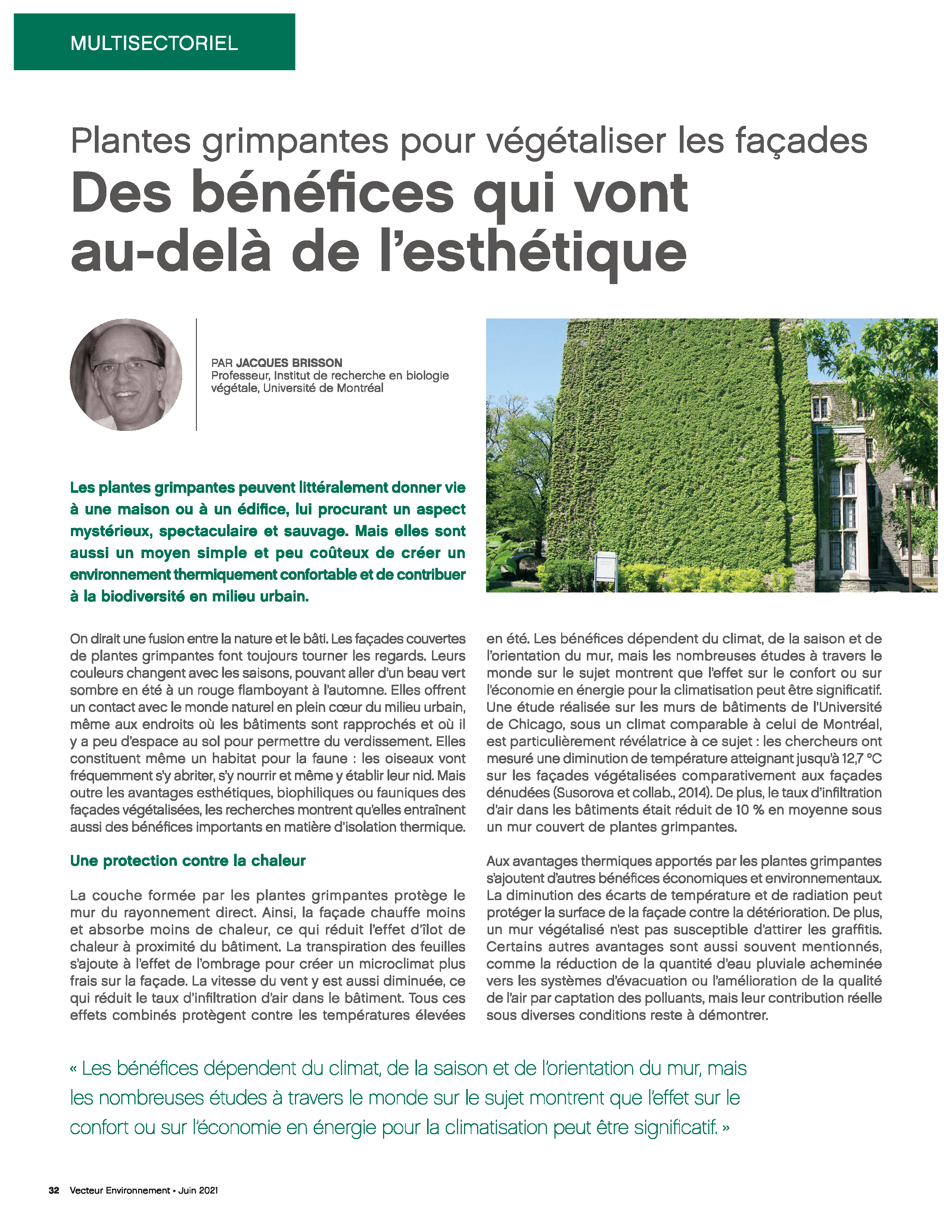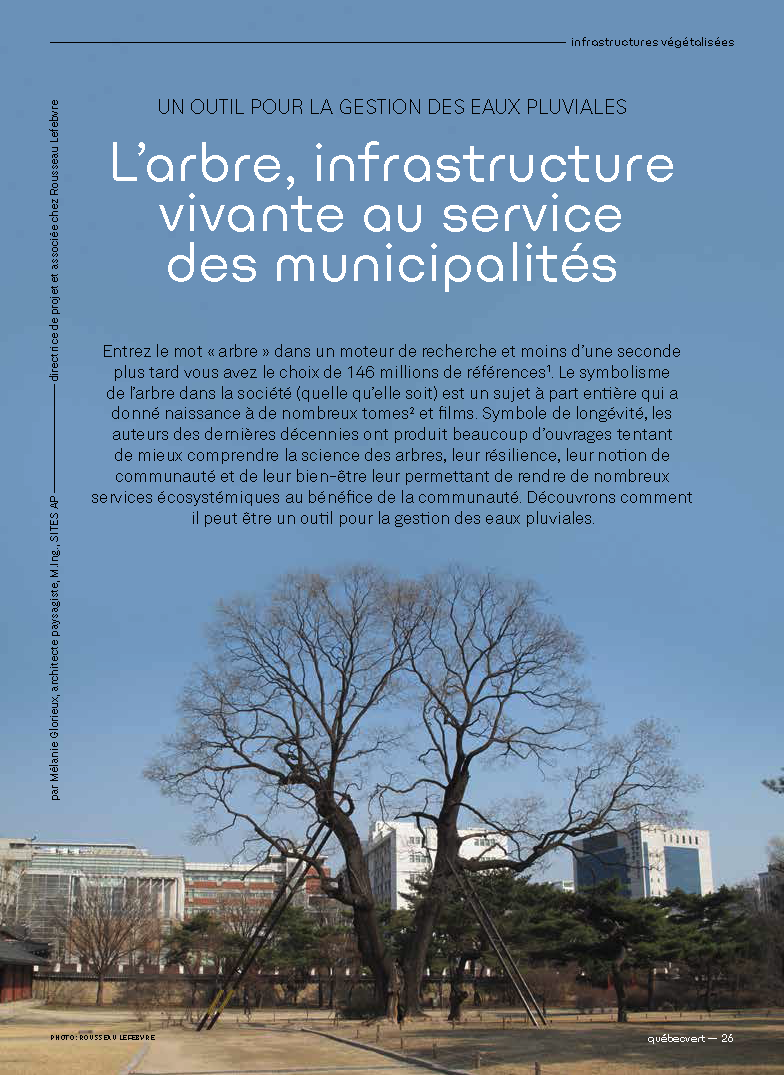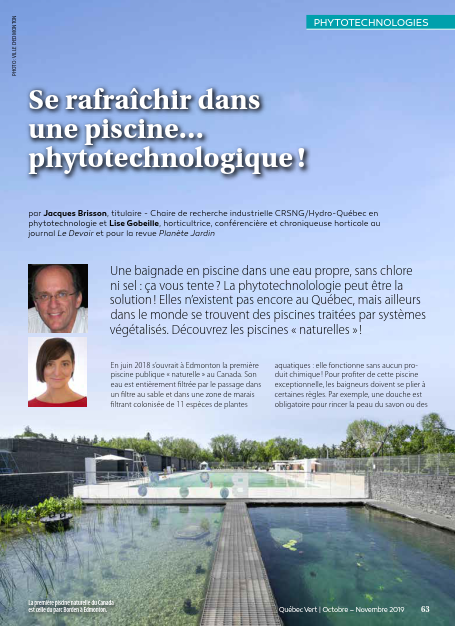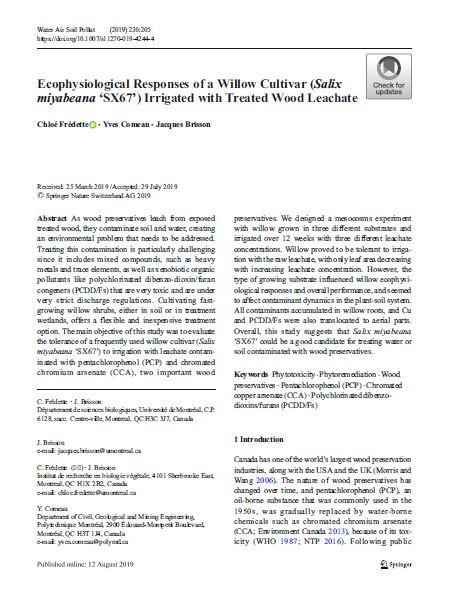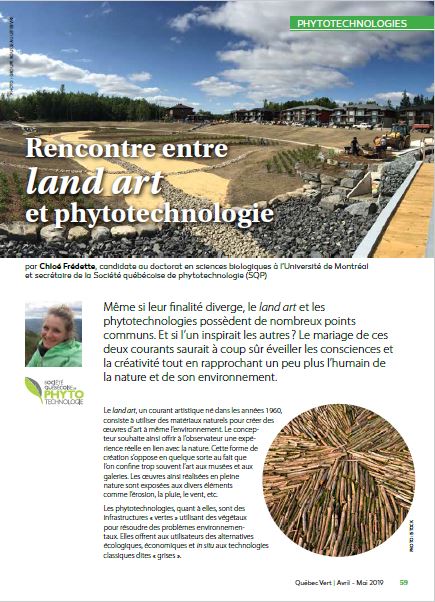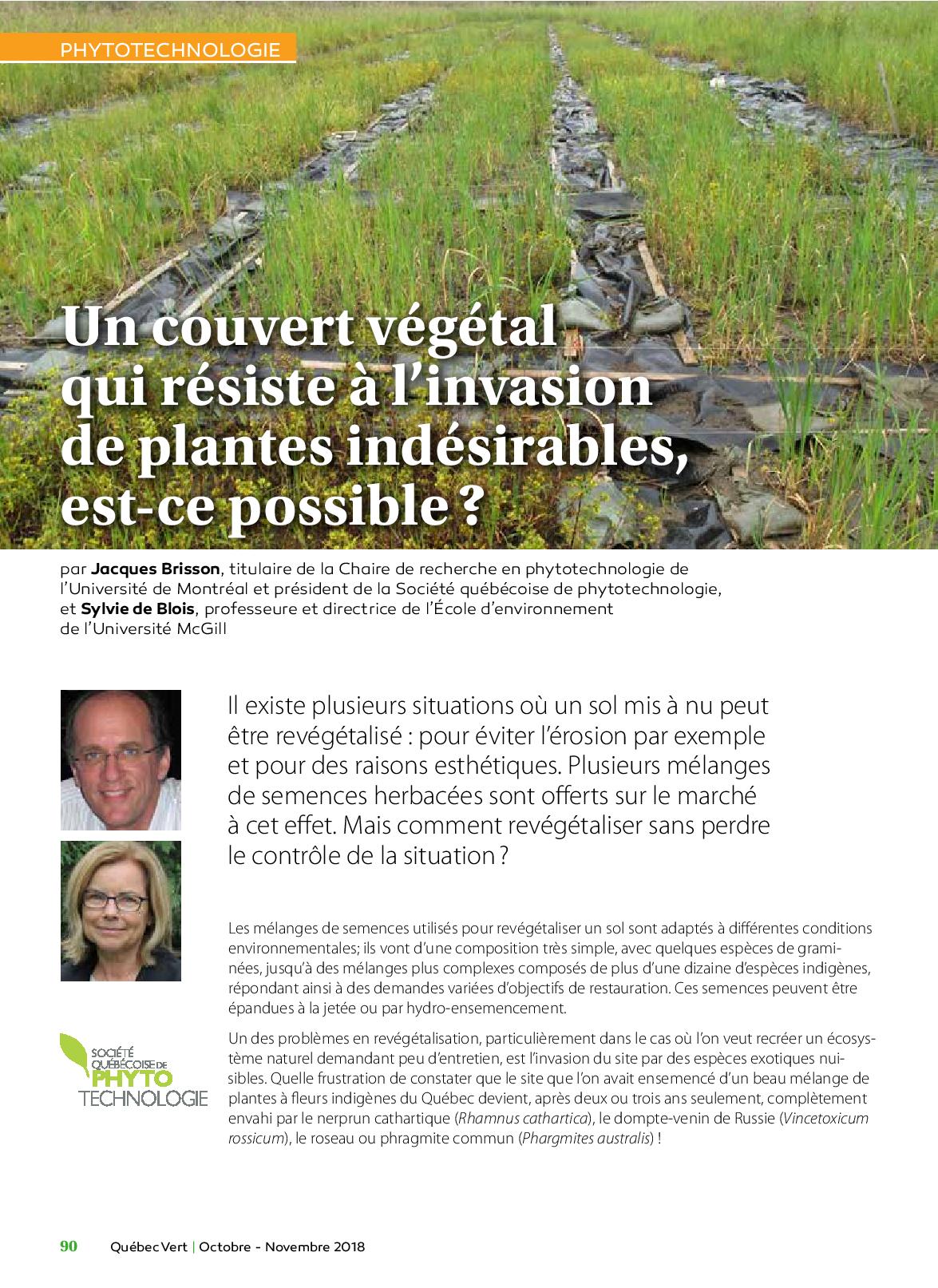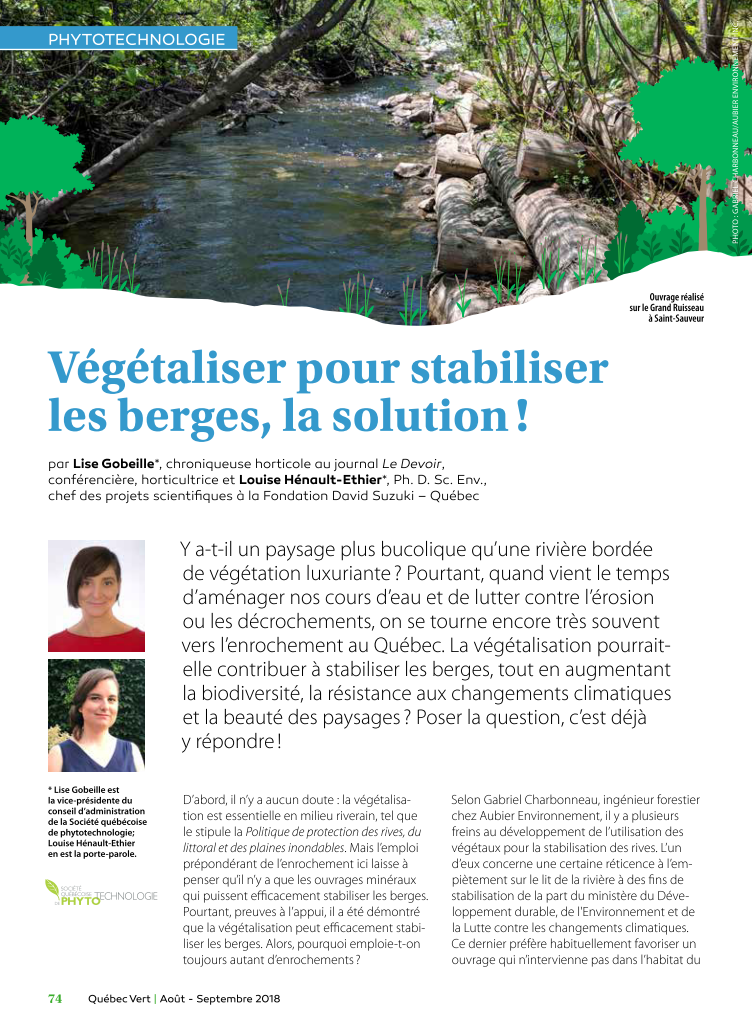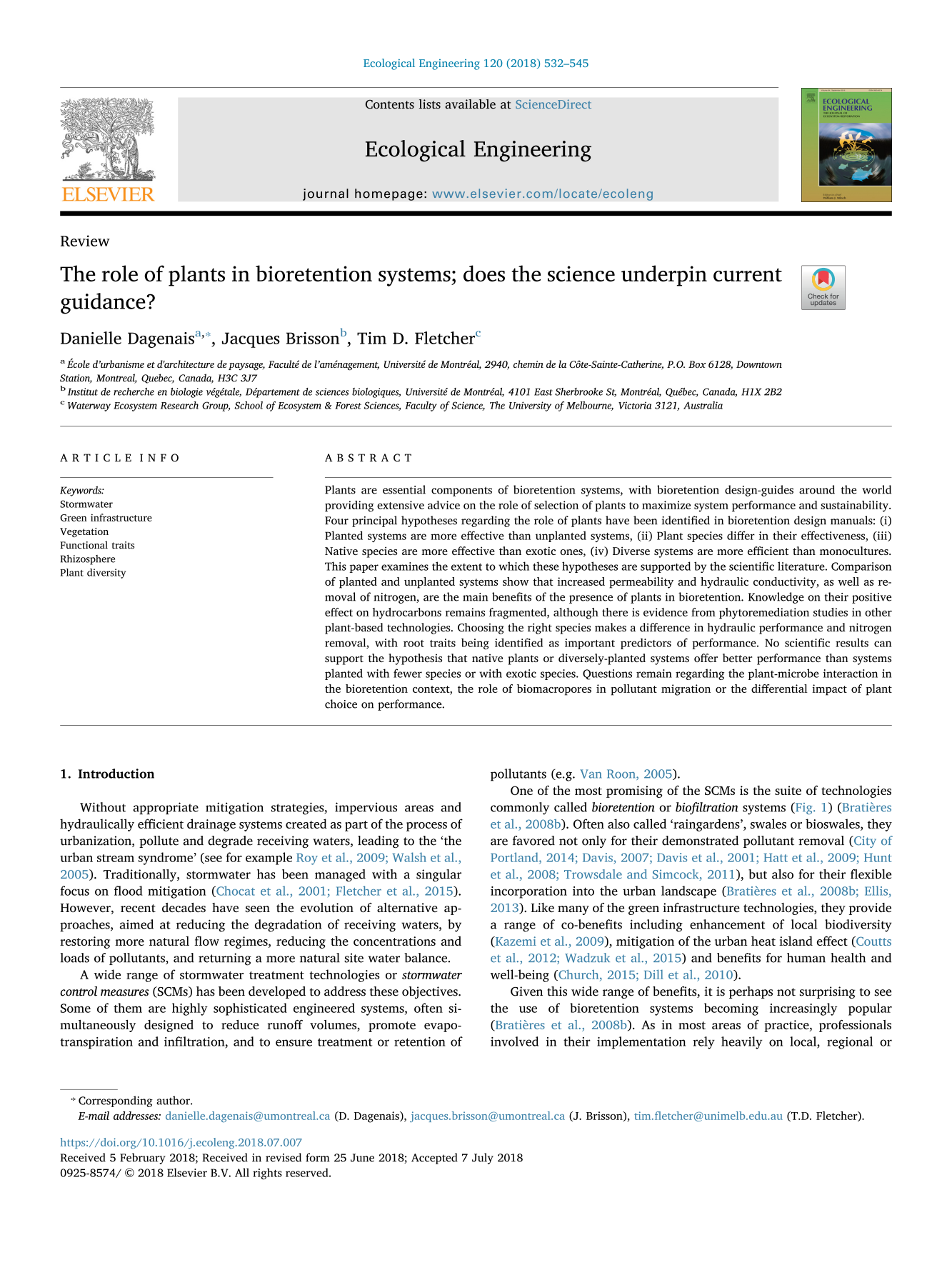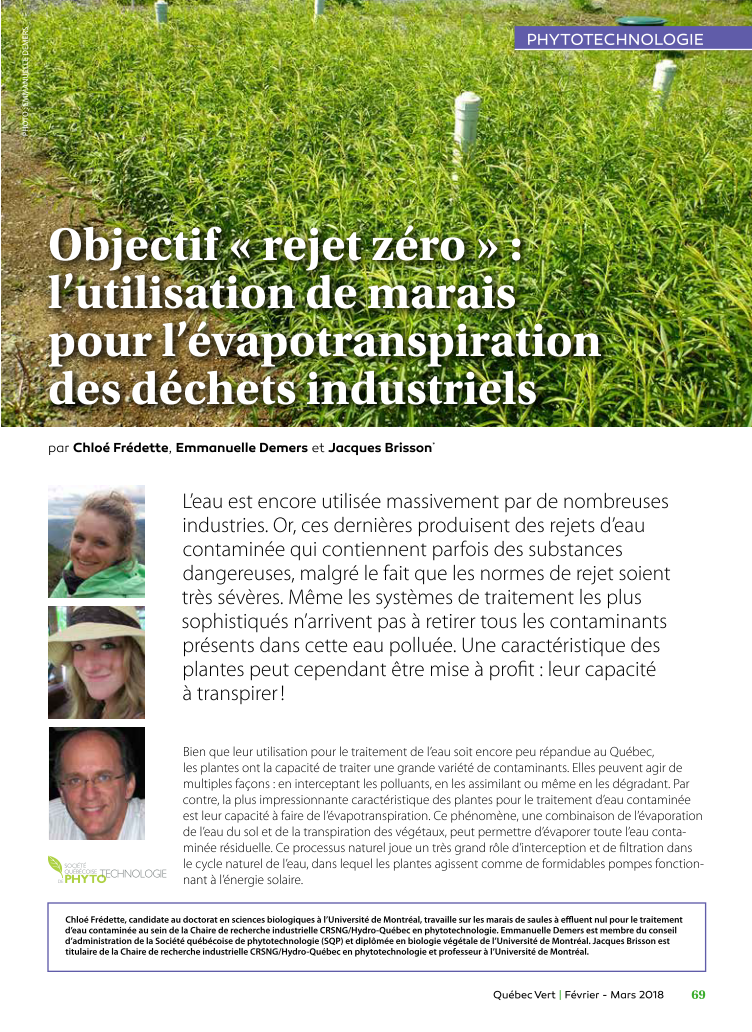Publications et rapports
Vous trouverez ici toutes les publications que les administrateurs et employés de la SQP ont effectuées pendant leur mandat et des rapports avec des retombées importantes
Cellules de biorétention et toitures végétalisées : bonnes pratiques d'entretien
Boucher-Carrier, O., Dufresne, C. et Hauchard, S. (2025). Cellules de biorétention et toitures végétalisées : bonnes pratiques d'entretien. Québec Vert.
Aperçu du potentiel des marais flottants au Québec
Bédard, L. (2025). Aperçu du potentiel des marais flottants au Québec. La gestion durable de l’eau,Québec Vert.
Le rôle des solutions climatiques fondées sur la nature dans l’atteinte de la carboneutralité de la ville de Montréal d’ici 2050
Boudreau, D. (2024). Le rôle des solutions climatiques fondées sur la nature dans l’atteinte de la carboneutralité de la ville de Montréal d’ici 2050. Plan d’urbanisme et de mobilité de la ville de Montréal,Office de consultation publique de Montréal.
Génie végétal : Comment s'applique la Loi sur les ingénieurs dans ce domaine?
Gravel, M-J. et Marcoux, P. (2024). Génie végétal : Comment s'applique la Loi sur les ingénieurs dans ce domaine?. PLAN. Hiver 2025. Vol. 61, No 4, p.44.
Révision par Maxime Tisserant et Clémence Moreau
Rapport final : Mandat de services professionnels en conception d'aménagements de génie végétal dans le cadre du programme de réhabilitation des berges des grands parcs riverains de la Ville de Montréal.
Poulin, M., Evette, A., Raymond, P., Charbonneau, G. et Vaillancourt, M. (2024). Mandat de services professionnels en conception d'aménagements de génie végétal dans le cadre du programme de réhabilitation des berges des grands parcs riverains de la Ville de Montréal. Ville de Montréal. Juin 2024: p.91.
PHYTOTECHNOLOGIES : un pont entre l'urbanisme et la biodivertsité
Parra A. (2024). PHYTOTECHNOLOGIES : un pont entre l'urbanisme et la biodivertsité. Bâtivert. Hiver 2024 : 14-15.
Plant survival and growth in bioretention cells under a cold climate. Ecological Engineering
Champagne-Caron, J., Frédette, C., Poulin, M., et Grégoire, G. (2024). Plant survival and growth in bioretention cells under a cold climate. Ecological Engineering, 202, 107239.
Comment choisir des agencements de végétaux favorables à la biodiversité
Frédette, C., Laramée, L. et Mondor, A. (2024). Comment choisir des agencements de végétaux favorables à la biodiversité ? Magazine Québec Vert, Août-Sept. 2024, 99-105.
Plan climat : comment utiliser le végétal pour répondre à ses objectifs environnementaux
Frédette, C. (2024). Plan climat : comment utiliser le végétal pour répondre à ses objectifs environnementaux ? Magazine Québec Vert, Août-Sept. 2024, 21-24.
Gestion des eaux pluviales : les infrastructures bleu‑vert à la rescousse
Frédette, C. (2024). Gestion des eaux pluviales : les infrastructures bleu‑vert à la rescousse ! Magazine Québec Vert, Août-Sept. 2024, 66-68.
La production d’écomatériaux d’origine végétale
Frédette, C. (2024). La production d’écomatériaux d’origine végétale. Magazine Québec Vert, Avr.-mai 2024, 31-33.
Textiles horticoles : à la recherche de solutions écologiques
Frédette, C. (2024). Textiles horticoles : à la recherche de solutions écologiques. Magazine Québec Vert, Avr.-mai 2024, 43-49.
L’évolution des politiques pour sauvegarder la biodiversité
Frédette, C. (2024). L’évolution des politiques pour sauvegarder la biodiversité. Magazine Québec Vert, Mars-avr. 2024, 7-10.
Les communautés végétales sur la planète
Frédette, C. (2024). Les communautés végétales sur la planète. Magazine Québec Vert, Fév.-mars 2024, 57-60
Les initiatives mondiales en faveur des infrastructures végétalisées
Frédette, C. (2024). Les initiatives mondiales en faveur des infrastructures végétalisées. Magazine Québec Vert, Fév.-mars 2024, 25-30.
Les végétaux, créateurs d’expérience sensorielle
Frédette, C. (2024). Les végétaux, créateurs d’expérience sensorielle ! Magazine Québec Vert, Déc. 2023-Janv. 2024, 21-23.
Lettre d’opinion : Partager la nature, une pelouse à la fois
Fortin Faubert, M. et Huet, A. (2024). Lettre d’opinion : Partager la nature, une pelouse à la fois.La Presse, Montréal, Canada.
LawnShare: Identifying Potential for Land Diversification through the Transformation of Lawns
Fortin Faubert, M. and Huet A. (2024). LawnShare: Identifying Potential for Land Diversification through the Transformation of Lawns. 37.David Suzuki Foundation.
Opinion letter: With species at risk, three wildlife wishes for 2024
Plotkin, R. et Fortin Faubert, M. (2024). Opinion letter: With species at risk, three wildlife wishes for 2024.Montreal Gazette
La nature du futur : Un an après la COP15 / Compte rendu de l’après-midi conférences
Fortin Faubert, M., Khan, S., Rondia, E., Harnois, S. et Maison, C. (2024). La nature du futur : Un an après la COP15 / Compte rendu de l’après-midi conférences. Fondation David Suzuki et Conseil régional de l’environnement de Montréal.
Partage ta pelouse : identifier le potentiel de diversification du territoire par la transformation des pelouses
Fortin Faubert, M. et Huet A. (2024). Partage ta pelouse : identifier le potentiel de diversification du territoire par la transformation des pelouses.Fondation David Suzuki
Les outils d’aide à la décision comme instrument pour favoriser l’utilisation de la phytoremédiation dans la province du Québec
Gomez, E. H. (2023). Les outils d’aide à la décision comme instrument pour favoriser l’utilisation de la phytoremédiation dans la province du Québec.
Growth trials on vegetables, herbs and flowers using mealworm frass, chicken manure and municipal compost
Hénault-Ethier, L., Reid, B., Hotte N., Paris, N., Quinche, M., Lachance, C., Fortin, A., Normandin, É., Laderrière, V. et Vandenberge G. (2023). Growth trials on vegetables, herbs and flowers using mealworm frass, chicken manure and municipal compost. 1-26.
Suivi de l’évolution des végétaux implantés dans des systèmes végétalisés de gestion des eaux pluviales
Champagne-Caron, J. (2023). Suivi de l’évolution des végétaux implantés dans des systèmes végétalisés de gestion des eaux pluviales. Mémoire de maîtrise, Université Laval.
Treatment of landfill leachate treatment by short-rotation willow coppice plantations in a large-scale experiment in eastern Canada. Plants
Benoist, P., Parrott, A., Lachapelle-T, X., Barbeau, L.C., Comeau, Y., Pitre, F.E. and Labrecque, M. (2023). Treatment of landfill leachate treatment by short-rotation willow coppice plantations in a large-scale experiment in eastern Canada. Plants. 12, 372.
S’adapter au climat par le verdissement
Fortin Faubert, M., Hénault-Ethier, L. et Duchesne, S. (2023). S’adapter au climat par le verdissement.Union Des Municipalités Du Québec (UMQ).
Mémoire déposé dans le cadre de la consultation publique devant mener à l’élaboration de la nouvelle Stratégie montréalaise de l’eau - L’avenir de l’eau de Montréal.
Leduc-Frenette S., Duchesne S., S. Langlois V., Lavoie I., Drogui P., Fortin Faubert M., Boushabi M., Ouarda T., Enders E., Célicourt P., N. Rousseau A., Foulon E., Stolle J. et Hénault-Ethier L. (2023). Mémoire déposé dans le cadre de la consultation publique devant mener à l’élaboration de la nouvelle Stratégie montréalaise de l’eau - L’avenir de l’eau de Montréal.INRS-Centre Eau, Terre et Environnement.
Lettre d’opinion : Prendre soin des poumons verts de nos villes.
Martin K., Handa T., Gachon P., Paquette A., Paquito B., Hiên Pham T.T., Ziter C., Fortin Faubert M., Dernis L., Clermont P., Ofiara L.M., Ross B., Schwartzman K, Généreux V., Robitaille N., Gravel D., Pétrin-Desrosiers C., Assayag D., Azuelos I., Rabinovitch B., Ernst P., Gonzalez A., Baltzan M., Pepe C.,Wood S., Pamidi S., Dupras J., Houle J., Laforest-Lapointe I., Festa-Bianchet M., Qureshi S., Bélisle M., Potvin C et Barbour M. (2023). Lettre d’opinion : Prendre soin des poumons verts de nos villes.La Presse.
Lettre ouverte : Québec doit considérer le caractère collectif des sols
Fortin Faubert, M. et Hallmich, C. (2023). Lettre ouverte : Québec doit considérer le caractère collectif des sols. La presse Plus. Montréal, Canada
Ectomycorrhizal Fungi Dominated the Root and Rhizosphere Microbial Communities of Two Willow Cultivars Grown for Six-Years in a Mixed- Contaminated Environment
Fortin Faubert, M., Desjardins, D., Hijri, M., Labrecque, M. (2022). Ectomycorrhizal Fungi Dominated the Root and Rhizosphere Microbial Communities of Two Willow Cultivars Grown for Six-Years in a Mixed- Contaminated Environment.Journal of Fungi. 8(2): 145.
Résumé de rapport scientifique : Outil d’aide à la décision pour le verdissement de terrains vacants potentiellement contaminés en milieux urbains
Fortin Faubert, M., Hénault-Ethier, L., Hallmich, C. (2022). Résumé de rapport scientifique : Outil d’aide à la décision pour le verdissement de terrains vacants potentiellement contaminés en milieux urbains. 6.Fondation David Suzuki.
Adaptation aux changements climatiques et villes durables – Outil d’aide à la décision pour le verdissement de terrains vacants potentiellement contaminés en milieux urbains
Fortin Faubert, M.; Hénault-Ethier, L.; Hallmich, C. (2022). Adaptation aux changements climatiques et villes durables – Outil d’aide à la décision pour le verdissement de terrains vacants potentiellement contaminés en milieux urbains. 49.Fondation David Suzuki,
Scientific Report Summary: Developing a Decision-Support Tool for Greening Potentially Contaminated Vacant Lots in Urban Areas
Fortin Faubert, M., Hénault-Ethier, L. et Hallmich C. (2022). Scientific Report Summary: Developing a Decision-Support Tool for Greening Potentially Contaminated Vacant Lots in Urban Areas. 6.Fondation David Suzuki
Impacts des changements climatiques sur les forêts - État de la science et moyens d'adaptation
Benoist, P., Elferjani, R., Thiffault, N. and Bélanger, N. (2022). Impacts des changements climatiques sur les forêts - État de la science et moyens d'adaptation. Le progrès forestier. 16-19.
Les terrains vacants : un passif ou un actif méconnu pour les municipalités ?
Fortin Faubert, M. (2022). Les terrains vacants : un passif ou un actif méconnu pour les municipalités ?. Québec Vert, août : 69-73.
Approvisionnement en végétaux pour les infrastructures végétalisées : bonnes pratiques ?
Frédette, C. (2022). Approvisionnement en végétaux pour les infrastructures végétalisées : bonnes pratiques ?. Québec Vert, août : 1-20.
Fleurir, aménager et améliorer : les effets sociaux des espaces verts
Houbart, C. (2022). Fleurir, aménager et améliorer : les effets sociaux des espaces verts. Québec Vert, août : 17-21.
Les bienfaits de la pelouse durable
Grégoire, G. (2022). Les bienfaits de la pelouse durable. Québec Vert, août : 17-21.
Quand infrastructures végétalisées rime avec multifonctionnalité et facilité
Frédette, C. (2022). Quand infrastructures végétalisées rime avec multifonctionnalité et facilité. Québec Vert, août : 85-91
Le plus grand projet de phytoremédiation au Canada se déroule dans l’Est de Montréal
Benoist, P. (2022). Le plus grand projet de phytoremédiation au Canada se déroule dans l’Est de Montréal. Québec Vert, juin : 38-41.
La phytoremédiation : un véritable bioréacteur naturel
Frédette, C. (2022). La phytoremédiation : un véritable bioréacteur naturel. Québec Vert, juin : 30-33.
Effects of plants and biochar on the performance of treatment wetlands for removal of the pesticide chlorantraniliprole from agricultural runoff
Abas, K., Brisson, J., Amyot, M., Brodeur, J., Storck, V., Montiel-León, J. M., Vo Duy, S., Sauvé, S. & Kõiv-Vainik, M. (2022). Effects of plants and biochar on the performance of treatment wetlands for removal of the pesticide chlorantraniliprole from agricultural runoff. Ecological Engineering, 175, 106477.
Effects of macrophyte species and biochar on the performance of treatment wetlands for the removal of glyphosate from agricultural runoff
Boucher-Carrier, O., Brisson, J., Abas, K., Duy, S. V., Sauvé, S., & Kõiv-Vainik, M. (2022). Effects of macrophyte species and biochar on the performance of treatment wetlands for the removal of glyphosate from agricultural runoff. Science of The Total Environment, 156061.
Phytochelatin and coumarin enrichment in root exudates of arsenic-treated white lupin
Frémont, A., Sas, E., Sarrazin, M., Gonzalez, E., Brisson, J., Pitre, F. E., & Brereton, N. J. B. (2022). Phytochelatin and coumarin enrichment in root exudates of arsenic‐treated white lupin. Plant Cell and Environment, 45(3), 936-954
Valuable alkaloids content is preserved in Camptotheca acuminata and Morus alba grown in trace elements contaminated soil
Lamontagne, J., Sas, E., Vincent, G., Shang, K., Pitre, F. E., & Labrecque, M. (2022). Valuable alkaloids content is preserved in Camptotheca acuminata and Morus alba grown in trace elements contaminated soil. International Journal of Phytoremediation, 1-10.
Les autoroutes : congestion d’impacts sur la santé humaine et environnementale
Hénault-Éthier L., Frédette, C., Bally, G. & Fortin Faubert, M. (2022). Les autoroutes : congestion d’impacts sur la santé humaine et environnementale. Québec Vert, avril : 58-63.
Nutrient-assisted phytoremediation of wood preservative–contaminated technosols with co-planting of Salix interior and Festuca arundinacea
Yavari, S., Courchesne, F., & Brisson, J. (2021). Nutrient-assisted phytoremediation of wood preservative–contaminated technosols with co-planting of Salix interior and Festuca arundinacea. Environmental Science and Pollution Research, 28(41), 58018-58034.
Optimiser la fertilisation azotée des pelouses pour réduire les pertes en azote par lessivage
Côté L. & Grégoire G. (2021). Optimiser la fertilisation azotée des pelouses pour réduire les pertes en azote par lessivage. Québec Vert, décembre : 39-44.
Les visages de la recherche
Bisson, R. & Brochu, M. (2021). Les visages de la recherche Québec Vert, décembre : 23-31.
Design of a zero liquid discharge leachate treatment system using an evapotranspiration willow bed
Frédette, C., Comeau, Y., & Brisson, J. (2021). Design of a zero liquid discharge leachate treatment system using an evapotranspiration willow bed. Water Research, 117950.
Bioaugmentation of treatment wetlands – A review
Tondera, K., Chazarenc, F., Chagnon, P. L., & Brisson, J. (2021). Bioaugmentation of treatment wetlands–a review. Science of The Total Environment, 775, 145820.
Short rotation intensive culture of willow, spent mushroom substrate and ramial chipped wood for bioremediation of a contaminated site used for land farming activities of a former petrochemical plant
Fortin Faubert, M., Hijri, M., & Labrecque, M. (2021). Short rotation intensive culture of willow, spent mushroom substrate and ramial chipped wood for bioremediation of a contaminated site used for land farming activities of a former petrochemical plant. Plants, 10(3), 520.
Willows Used for Phytoremediation Increased Organic Contaminant Concentrations in Soil Surface
Fortin Faubert, M., Desjardins, D., Hijri, M., & Labrecque, M. (2021). Willows Used for Phytoremediation Increased Organic Contaminant Concentrations in Soil Surface. Applied Sciences, 11(7), 2979.
Evaluation of long-term phosphorus uptake by Schoenoplectus californicus and Phragmites australis plants in pilot-scale constructed wetlands.
Carillo, V., Collins, C., Brisson, J. & Vidal, G. (2021). Evaluation of long-term phosphorus uptake by Schoenoplectus californicus and Phragmites australis plants in pilot-scale constructed wetlands. International journal of phytoremediation, 1-12.
Vers un réseau intégré d’infrastructures végétalisées au Québec
Frédette, C. (2021). Vers un réseau intégré d’infrastructures végétalisées au Québec. Québec Vert, août-septembre : 61-65.
Portrait de la Chaire de recherche en phytotechnologie
Brisson, J. (2021). Portrait de la Chaire de recherche en phytotechnologie. Québec Vert, avril-mai : 75-78.
Végétalisez vos murs et faites grimper votre performance
Brisson, J. & Frédette, C. (2021). Végétalisez vos murs et faites grimper votre performance. Québec Vert, juin-juillet : 60-64.
Plantes grimpantes pour végétaliser les façades, des bénéfices qui vont au-delà de l'esthétique
Brisson, J. (2021). Plantes grimpantes pour végétaliser les façades, des bénéfices qui vont au-delà de l'esthétique. Vecteur environnement, juin : 32-33.
Les plantes peuvent nous aider à lutter contre les changements climatiques
Beauchemin, G. (2021). Les plantes peuvent nous aider à lutter contre les changements climatiques. 24 heures, 29 avril : 21.
Macrophyte Potential to Treat Leachate Contaminated with Wood Preservatives: Plant Tolerance and Bioaccumulation Capacity
Demers, E., Kõiv-Vainik, M., Yavari, S., Mench, M., Marchand, L., Vincent, J., Frédette, C., Comeau, Y., Brisson, J. (2020). Macrophyte Potential to Treat Leachate Contaminated with Wood Preservatives: Plant Tolerance and Bioaccumulation Capacity. Plants, 2020 (9): 1774.
L’arbre, infrastructure vivante au service des municipalités
Glorieux, M. (2020). L’arbre, infrastructure vivante au service des municipalités. (2020). Québec Vert, août-sept. : 26-30.
Dans l'univers des toits verts
Grégoire, G. & Hénault-Éthier, L. (2020). Dans l'univers des toits verts. Québec Vert, août-sept. : 39-43.
Optimization of the wastewater treatment capacity of a short rotation willow coppice vegetation filter
Amiot, S., Jerbi, A., Lachapelle-T., Frédette, C., Labrecque, M. & Comeau, Y. (2020). Optimization of the wastewater treatment capacity of a short rotation willow coppice vegetation filter. Ecological Engineering, 158 (2020) : 106013.
Le pouvoir inégalé du verdissement
Hénault-Ethier, L., Gobeille, L., Grégoire, G., Brisson, J., Gosselin, P., Reeves, F. & Elsener, J. (2019). Le pouvoir inégalé du verdissement. Québec Vert, 330 : 14-21.
Des saules pour valoriser le lixiviat des lieux d’enfouissement
Lachapelle, T., Lacombe, G., Labrecque, M., & Comeau, Y. (2019). Des saules pour valoriser le lixiviat des lieux d’enfouissement. Vecteur Environnement, Décembre 2019, 36-37.
Se rafraîchir dans une piscine… phytotechnologique
Brisson, J. & Gobeille, L. (2019). Se rafraîchir dans une piscine… phytotechnologique ! Québec Vert, Octobre – Novembre 2019, 63-66.
Phytotechnologies : des normes pour la biorétention
Glorieux, M. (2019). Phytotechnologies : des normes pour la biorétention. Québec-Vert, Juin-Juillet, 55-57.
Establishment and potential use of woody species in treatment wetlands
Grebenshchykova, Z., Frédette, C., Chazarenc, F., Comeau, Y., & Brisson, J. (2019). Establishment and potential use of woody species in treatment wetlands. International Journal of Phytoremediation, 1-10.
Street Tree Pits as Bioretention Units: Effects of Soil Organic Matter and Area Permeability on the Volume and Quality of Urban Runoff
Frosi, M. H., Kargar, M., Jutras, P., Prasher, S. O., & Clark, O. G. (2019). Street Tree Pits as Bioretention Units: Effects of Soil Organic Matter and Area Permeability on the Volume and Quality of Urban Runoff. Water, Air, & Soil Pollution, 230(7), 152.
Ecophysiological responses of a willow cultivar (Salix miyabeana ‘SX67’) irrigated with treated wood leachate
Frédette, C., Comeau, Y., & Brisson, J. Ecophysiological responses of a willow cultivar (Salix miyabeana ‘SX67’) irrigated with treated wood leachate. Water, Air, & Soil Pollution, 230 : 1-15.
Willows for environmental projects: A literature review of results on evapotranspiration rate and its driving factors across the genus Salix
Frédette, C., Labrecque, M., Comeau, Y., Brisson, J. (2019). Willows for environmental projects: A literature review of results on evapotranspiration rate and its driving factors across the genus Salix. Journal of environmental management, 256: 526-537.
Revégétaliser sans favoriser les plantes indésirables
Brisson, J., de Blois, S., & Trejo, R. (2019). Revégétaliser sans favoriser les plantes indésirables. Quatre-Temps, 43(2): 44-45.
Rencontre entre land art et phytotechnologie
Frédette, C. (2019). Rencontre entre land art et phytotechnologie. Québec Vert, 41(2) : 59-62.
Evapotranspiration of a willow cultivar (Salix miyabeana SX67) grown in a full-scale treatment wetland
Frédette, C., Grebenshchykova, Z., Comeau, Y., Brisson, J. (2019). Evapotranspiration of a willow cultivar (Salix miyabeana SX67) grown in a full-scale treatment wetland. Ecological engineering, 127: 254-262.
Un couvert végétal qui résiste à l’invasion de plantes indésirables, est-ce possible
Brisson, J. et De Blois, S. (2018). Un couvert végétal qui résiste à l’invasion de plantes indésirables, est-ce possible? Québec Vert, Octobre-Novembre 2018. P. 90-94.
Moins de béton, plus de végétation dans les municipalités : une opportunité pour les horticulteurs
Houbart, C et Hénault-Éthier, L. (2018). Moins de béton, plus de végétation dans les municipalités : une opportunité pour les horticulteurs. Québec Vert, Août-Septembre 2018. P. 67-71.
Végétaliser pour stabiliser les berges, la solution
Gobeille, L et Hénault-Éthier, L. (2018). Végétaliser pour stabiliser les berges, la solution! Québec Vert, Février-Mars 2018. P. 74-78.
The role of plants in bioretention systems; does the science underpin current guidance
Dagenais, D., Brisson, J. et D. Fletcher, T. (2018). The role of plants in bioretention systems; does the science underpin current guidance? Ecological Engineering, 120 : 532-545.


